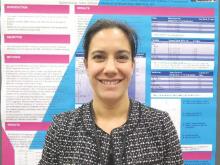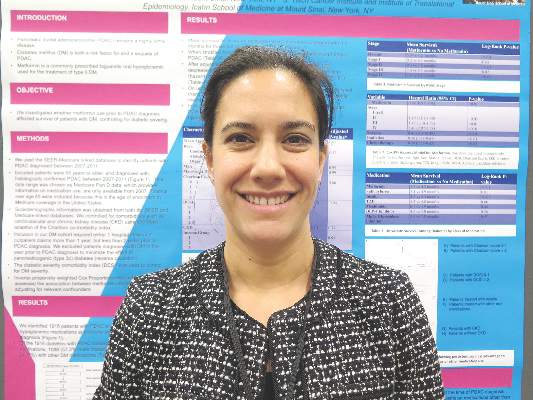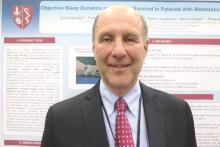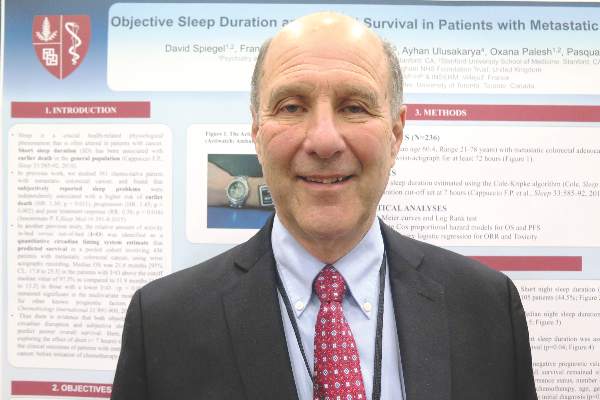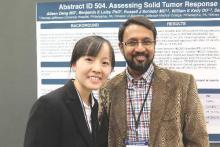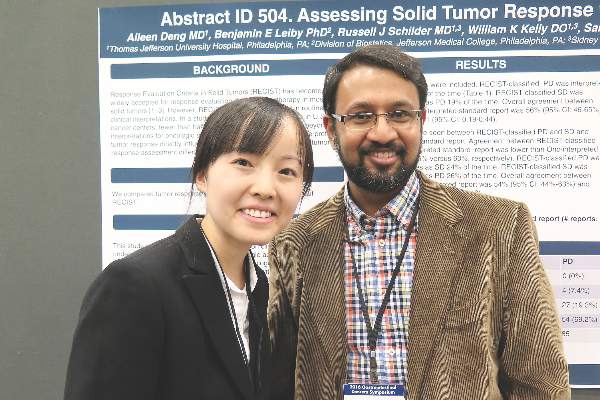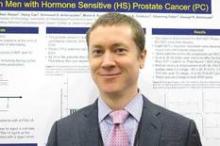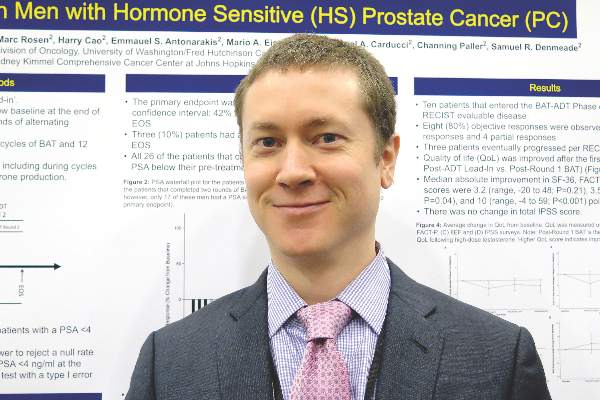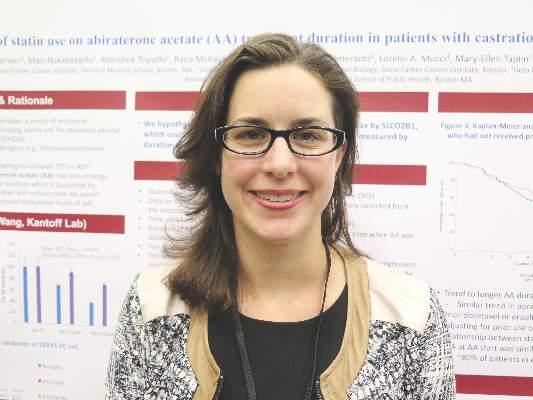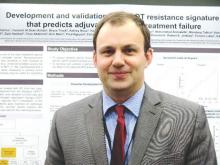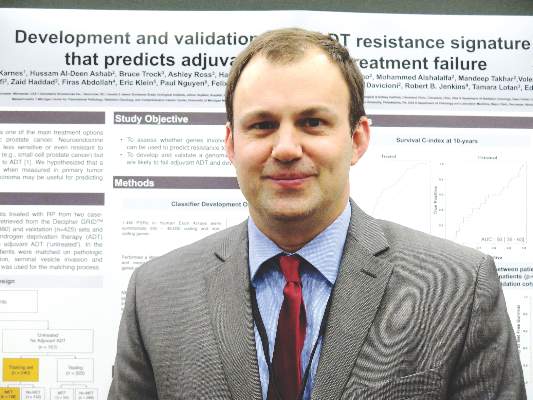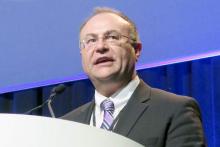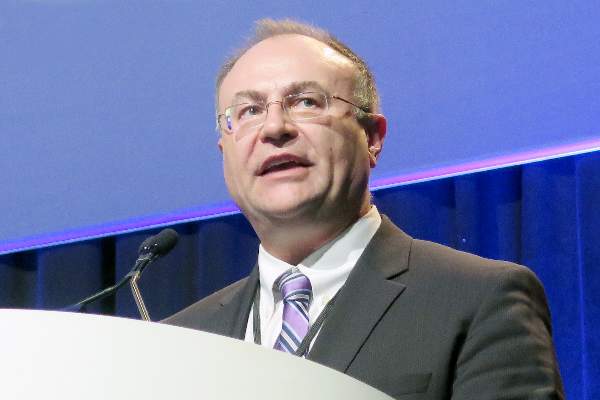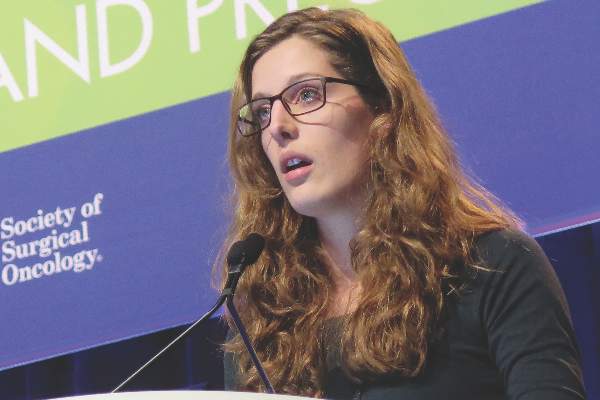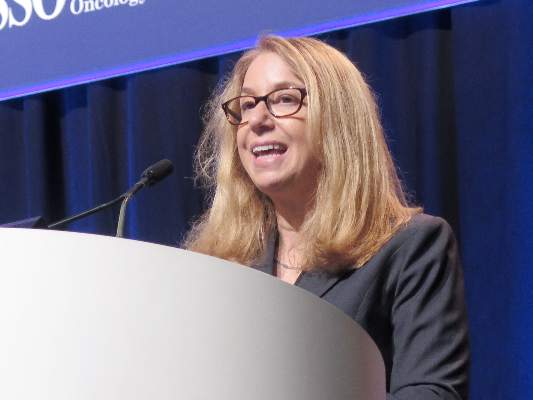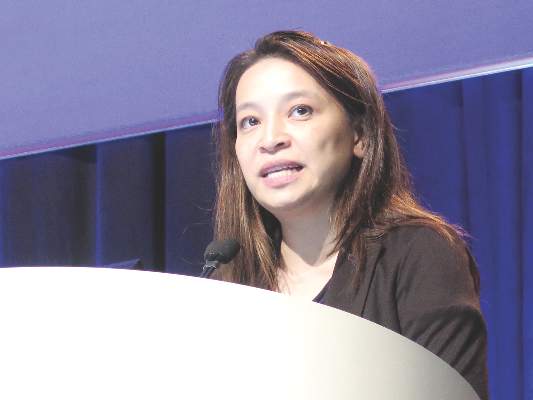User login
Common medications linked to better survival in pancreatic cancer
SAN FRANCISCO – A variety of commonly used medications may improve survival of pancreatic cancer, reducing the risk of death by up to one-fourth, according to a pair of national retrospective cohort studies reported in a poster session at the Gastrointestinal Cancers Symposium.
In the first study, Dr. Muhammad S. Beg and his colleagues analyzed data from Surveillance, Epidemiology and End Results (SEER)-Medicare Part D beneficiaries with pancreatic cancer for the years 2006-2009. Patients were defined as using a medication if they filled at least two prescriptions within a year of the diagnosis.
“There is mounting preclinical evidence that medications conventionally used for noncancer indications may have an effect on pancreatic cancer biology and can potentially impart an effect on cancer outcome,” Dr. Beg said in an interview.
However, “validating each of these findings in the clinic in the form of prospective clinical trials is not feasible due to constraints related to resources and time. Historically, institutional cancer registries lack details on patient comorbidity and medication usage. As a result, prior studies are limited to small database analysis and results have been mixed,” he added. “Availability of large clinical datasets allows the impact of these medications to be evaluated on large numbers of cancer patients.”
Multivariate analyses based on 13,702 patients with pancreatic adenocarcinoma showed that the adjusted risk of death was significantly lower for users of beta-blockers (hazard ratio, 0.92), warfarin (HR, 0.90), insulin (HR, 0.89), and heparin (HR, 0.76).
The findings are most noteworthy for warfarin, which appears to act through inhibition of the gas6-axl pathway, according to Dr. Beg of UT Southwestern Medical Center, Simmons Cancer Center, Dallas.
“Warfarin is an old drug, cheap and no one really likes it as it is tough for patients to take,” he elaborated. But “we have a potential mechanism of action and a new class of drugs, AXL inhibitors, which given this information should be explored in pancreatic cancer.”
In contrast, risk of death was not affected by use of statins, thiazolidinediones, or metformin. “That metformin did not have an effect goes against a large number of studies [that] suggested metformin could be very active in pancreatic cancer,” Dr. Beg said.
“In a cancer [that] has such dismal outcome as pancreatic cancer, understanding how to best use concurrent medications may have significant impact on patients’ outcomes and our understanding of the cancer biology,” he concluded.
In the second study, Dr. Aimee Lucas and her colleagues analyzed data from SEER-Medicare Part D beneficiaries with pancreatic cancer for the years 2007-2011. They excluded those receiving a diabetes diagnosis in the year before their cancer diagnosis to minimize the effect of reverse causation, whereby the cancer led to diabetes.
Analyses were based on 1,916 patients with pancreatic adenocarcinoma who were taking medications for diabetes before their cancer diagnosis. Overall, 57% used metformin, with or without other medications.
In propensity-adjusted analyses, mean survival was longer for metformin users than for nonusers (5.5 vs. 4.2 months; P less than .01), reported Dr. Lucas of the Icahn School of Medicine at Mount Sinai, New York. The difference was significant across stages, except for stage I.
In multivariate analysis, metformin users still had a reduced risk of death (hazard ratio, 0.88; P less than .01). The association was consistent across subgroups of patients stratified by Charlson comorbidity score, diabetic complications severity index score, presence of chronic kidney disease, and use of insulin or other hypoglycemic agents.
On the other hand, insulin users had poorer survival than nonusers (4.3 vs. 5.5 months; P less than .01). And survival did not differ significantly according to use of sulfonylureas, thiazolidinediones, meglitinides, dipeptidyl peptidase 4 (DPP-4) inhibitors, or alpha-glucosidase inhibitors.
“We think that this study provides growing evidence for a survival benefit for diabetics who are on metformin at the time of diagnosis, and we would be interested in further work to try to figure out why,” Dr. Lucas said in an interview at the symposium, which was sponsored by the ASCO, ASTRO, the American Gastroenterological Association, and the Society of Urologic Oncology.
More research will be needed in particular to determine whether the findings for metformin represent a true protective effect of the drug or, rather, a harmful effect of other medications such as insulin, she added.
Dr. Lucas likewise noted the power of being able to tap into a large database that captures medication use and comorbidities when studying these associations in pancreatic cancer.
Smaller and single-institution cohorts studies have been done, she commented. But “no one has really been able to control for severity of diabetes and comorbidities in the same way that we were able to. And that’s just because we have the SEER-Medicare database and such a large sample size.”
SAN FRANCISCO – A variety of commonly used medications may improve survival of pancreatic cancer, reducing the risk of death by up to one-fourth, according to a pair of national retrospective cohort studies reported in a poster session at the Gastrointestinal Cancers Symposium.
In the first study, Dr. Muhammad S. Beg and his colleagues analyzed data from Surveillance, Epidemiology and End Results (SEER)-Medicare Part D beneficiaries with pancreatic cancer for the years 2006-2009. Patients were defined as using a medication if they filled at least two prescriptions within a year of the diagnosis.
“There is mounting preclinical evidence that medications conventionally used for noncancer indications may have an effect on pancreatic cancer biology and can potentially impart an effect on cancer outcome,” Dr. Beg said in an interview.
However, “validating each of these findings in the clinic in the form of prospective clinical trials is not feasible due to constraints related to resources and time. Historically, institutional cancer registries lack details on patient comorbidity and medication usage. As a result, prior studies are limited to small database analysis and results have been mixed,” he added. “Availability of large clinical datasets allows the impact of these medications to be evaluated on large numbers of cancer patients.”
Multivariate analyses based on 13,702 patients with pancreatic adenocarcinoma showed that the adjusted risk of death was significantly lower for users of beta-blockers (hazard ratio, 0.92), warfarin (HR, 0.90), insulin (HR, 0.89), and heparin (HR, 0.76).
The findings are most noteworthy for warfarin, which appears to act through inhibition of the gas6-axl pathway, according to Dr. Beg of UT Southwestern Medical Center, Simmons Cancer Center, Dallas.
“Warfarin is an old drug, cheap and no one really likes it as it is tough for patients to take,” he elaborated. But “we have a potential mechanism of action and a new class of drugs, AXL inhibitors, which given this information should be explored in pancreatic cancer.”
In contrast, risk of death was not affected by use of statins, thiazolidinediones, or metformin. “That metformin did not have an effect goes against a large number of studies [that] suggested metformin could be very active in pancreatic cancer,” Dr. Beg said.
“In a cancer [that] has such dismal outcome as pancreatic cancer, understanding how to best use concurrent medications may have significant impact on patients’ outcomes and our understanding of the cancer biology,” he concluded.
In the second study, Dr. Aimee Lucas and her colleagues analyzed data from SEER-Medicare Part D beneficiaries with pancreatic cancer for the years 2007-2011. They excluded those receiving a diabetes diagnosis in the year before their cancer diagnosis to minimize the effect of reverse causation, whereby the cancer led to diabetes.
Analyses were based on 1,916 patients with pancreatic adenocarcinoma who were taking medications for diabetes before their cancer diagnosis. Overall, 57% used metformin, with or without other medications.
In propensity-adjusted analyses, mean survival was longer for metformin users than for nonusers (5.5 vs. 4.2 months; P less than .01), reported Dr. Lucas of the Icahn School of Medicine at Mount Sinai, New York. The difference was significant across stages, except for stage I.
In multivariate analysis, metformin users still had a reduced risk of death (hazard ratio, 0.88; P less than .01). The association was consistent across subgroups of patients stratified by Charlson comorbidity score, diabetic complications severity index score, presence of chronic kidney disease, and use of insulin or other hypoglycemic agents.
On the other hand, insulin users had poorer survival than nonusers (4.3 vs. 5.5 months; P less than .01). And survival did not differ significantly according to use of sulfonylureas, thiazolidinediones, meglitinides, dipeptidyl peptidase 4 (DPP-4) inhibitors, or alpha-glucosidase inhibitors.
“We think that this study provides growing evidence for a survival benefit for diabetics who are on metformin at the time of diagnosis, and we would be interested in further work to try to figure out why,” Dr. Lucas said in an interview at the symposium, which was sponsored by the ASCO, ASTRO, the American Gastroenterological Association, and the Society of Urologic Oncology.
More research will be needed in particular to determine whether the findings for metformin represent a true protective effect of the drug or, rather, a harmful effect of other medications such as insulin, she added.
Dr. Lucas likewise noted the power of being able to tap into a large database that captures medication use and comorbidities when studying these associations in pancreatic cancer.
Smaller and single-institution cohorts studies have been done, she commented. But “no one has really been able to control for severity of diabetes and comorbidities in the same way that we were able to. And that’s just because we have the SEER-Medicare database and such a large sample size.”
SAN FRANCISCO – A variety of commonly used medications may improve survival of pancreatic cancer, reducing the risk of death by up to one-fourth, according to a pair of national retrospective cohort studies reported in a poster session at the Gastrointestinal Cancers Symposium.
In the first study, Dr. Muhammad S. Beg and his colleagues analyzed data from Surveillance, Epidemiology and End Results (SEER)-Medicare Part D beneficiaries with pancreatic cancer for the years 2006-2009. Patients were defined as using a medication if they filled at least two prescriptions within a year of the diagnosis.
“There is mounting preclinical evidence that medications conventionally used for noncancer indications may have an effect on pancreatic cancer biology and can potentially impart an effect on cancer outcome,” Dr. Beg said in an interview.
However, “validating each of these findings in the clinic in the form of prospective clinical trials is not feasible due to constraints related to resources and time. Historically, institutional cancer registries lack details on patient comorbidity and medication usage. As a result, prior studies are limited to small database analysis and results have been mixed,” he added. “Availability of large clinical datasets allows the impact of these medications to be evaluated on large numbers of cancer patients.”
Multivariate analyses based on 13,702 patients with pancreatic adenocarcinoma showed that the adjusted risk of death was significantly lower for users of beta-blockers (hazard ratio, 0.92), warfarin (HR, 0.90), insulin (HR, 0.89), and heparin (HR, 0.76).
The findings are most noteworthy for warfarin, which appears to act through inhibition of the gas6-axl pathway, according to Dr. Beg of UT Southwestern Medical Center, Simmons Cancer Center, Dallas.
“Warfarin is an old drug, cheap and no one really likes it as it is tough for patients to take,” he elaborated. But “we have a potential mechanism of action and a new class of drugs, AXL inhibitors, which given this information should be explored in pancreatic cancer.”
In contrast, risk of death was not affected by use of statins, thiazolidinediones, or metformin. “That metformin did not have an effect goes against a large number of studies [that] suggested metformin could be very active in pancreatic cancer,” Dr. Beg said.
“In a cancer [that] has such dismal outcome as pancreatic cancer, understanding how to best use concurrent medications may have significant impact on patients’ outcomes and our understanding of the cancer biology,” he concluded.
In the second study, Dr. Aimee Lucas and her colleagues analyzed data from SEER-Medicare Part D beneficiaries with pancreatic cancer for the years 2007-2011. They excluded those receiving a diabetes diagnosis in the year before their cancer diagnosis to minimize the effect of reverse causation, whereby the cancer led to diabetes.
Analyses were based on 1,916 patients with pancreatic adenocarcinoma who were taking medications for diabetes before their cancer diagnosis. Overall, 57% used metformin, with or without other medications.
In propensity-adjusted analyses, mean survival was longer for metformin users than for nonusers (5.5 vs. 4.2 months; P less than .01), reported Dr. Lucas of the Icahn School of Medicine at Mount Sinai, New York. The difference was significant across stages, except for stage I.
In multivariate analysis, metformin users still had a reduced risk of death (hazard ratio, 0.88; P less than .01). The association was consistent across subgroups of patients stratified by Charlson comorbidity score, diabetic complications severity index score, presence of chronic kidney disease, and use of insulin or other hypoglycemic agents.
On the other hand, insulin users had poorer survival than nonusers (4.3 vs. 5.5 months; P less than .01). And survival did not differ significantly according to use of sulfonylureas, thiazolidinediones, meglitinides, dipeptidyl peptidase 4 (DPP-4) inhibitors, or alpha-glucosidase inhibitors.
“We think that this study provides growing evidence for a survival benefit for diabetics who are on metformin at the time of diagnosis, and we would be interested in further work to try to figure out why,” Dr. Lucas said in an interview at the symposium, which was sponsored by the ASCO, ASTRO, the American Gastroenterological Association, and the Society of Urologic Oncology.
More research will be needed in particular to determine whether the findings for metformin represent a true protective effect of the drug or, rather, a harmful effect of other medications such as insulin, she added.
Dr. Lucas likewise noted the power of being able to tap into a large database that captures medication use and comorbidities when studying these associations in pancreatic cancer.
Smaller and single-institution cohorts studies have been done, she commented. But “no one has really been able to control for severity of diabetes and comorbidities in the same way that we were able to. And that’s just because we have the SEER-Medicare database and such a large sample size.”
AT THE GASTROINTESTINAL CANCERS SYMPOSIUM
Key clinical point: Use of certain common medications is associated with better survival in patients with pancreatic cancer.
Major finding: Risk of death was lower for users of beta-blockers (hazard ratio, 0.92), warfarin (0.90), insulin (0.89), and heparin (0.76). Among diabetic patients, risk was lower for users of metformin (0.88).
Data source: A pair of national retrospective cohort studies among 13,702 patients with pancreatic cancer and 1,916 patients with both pancreatic cancer and diabetes.
Disclosures: Dr. Beg disclosed that he has a consulting or advisory role with Celgene, that he is on the speakers bureau of Bayer/Onyx, and that he receives research funding from Celgene, miRNA Therapeutics, and Precision Biologics. Dr. Lucas disclosed that she has no relevant conflicts of interest.
Short sleep duration increases risk of death in patients with metastatic colorectal cancer
SAN FRANCISCO – Sleep duration influences survival in the metastatic colorectal cancer population, according to a cohort study of 236 patients who wore wrist actigraphy devices for the 72 hours leading up to chemotherapy.
Those who slept 7 hours nightly or less had a 45% higher adjusted 5-year risk of death when compared with counterparts who logged more hours, investigators reported in a poster session at the Gastrointestinal Cancers Symposium.
“If you’ve got advanced cancer, losing sleep is something to lose sleep over. It would be a good idea to view part of your overall health program as making sure you get an adequate amount of sleep,” first author Dr. David Spiegel said in an interview.
“The nice thing about this is, all of our patients could spend almost a third of their lives in bed asleep, and it’s an easy thing to advise them to do and try and help them to do,” he added. “If we had a chemotherapy that had this kind of effect in this setting, we’d be very happy about that. So it’s something we can do that is low risk, no side effects, that can actually have an effect on outcome.”
The mechanisms at play are still unclear, according to Dr. Spiegel, who is the Jack, Samuel, and Lulu Willson Professor of Medicine, Stanford (Calif.) University.
One possibility is perturbation of cortisol levels. “Cortisol has anti-inflammatory effects. Pro-inflammatory cytokines can trigger [vascular endothelial growth factor], which can provide metastatic tumors with more vascular support,” he elaborated. “Cortisol also affects tumor suppressor gene expression… So it’s conceivable that you are having different levels of cortisol throughout the day and night that may have a subtle effect on inflammation or expression of tumor suppressor genes.”
Alternately, short sleep may be a marker for other lifestyle factors negatively affecting prognosis, he proposed. “People who don’t sleep well don’t exercise as well. They may not eat as well. There are a lot of other systems that kind of get triggered,” he said at the symposium, sponsored by the American Society of Clinical Oncology, ASTRO, and the Society of Urologic Oncology.
In previous research, the investigators found that subjectively reported sleep problems in chemotherapy-naïve patients with metastatic colorectal cancer were associated with increased risks of progression, death, and poor treatment response (Sleep Med. 2015 Mar;16:391-8). Additionally, patients with metastatic colorectal cancer with a longer objectively measured proportion of time in bed had better overall survival (Chronobiol Int. 2014 Oct;31:891-900).
In the new study, the median nightly sleep duration was 7.4 hours per night for the entire cohort. Compared with others, patients sleeping 7 hours nightly or less had poorer median overall survival (14.6 vs. 16.4 months, P = .04), and this association remained significant after adjusting for clinical, disease, and treatment factors (hazard ratio, 1.45; P = .012).
“What’s interesting is it’s not simply, as your disease is progressing, you are more anxious, you don’t sleep as well. You are dying anyway, so you are not sleeping well,” Dr. Spiegel commented. “This is a 5-year prediction of subsequent survival. And if you look at the curves, they stay separated pretty much throughout the ensuing 5 years. So it seems to be a strong and independent predictor of mortality.”
In contrast, short sleep duration was not significantly associated with progression-free survival, objective response rate, or grade 3 or 4 toxicity.
The findings are generally consistent with those of a study among women with metastatic breast cancer showing an impact of sleep on survival (Sleep. 2014 May 1;37:837-42). However, in that study, sleep efficiency, not duration, was associated with survival.
“My colleague Oxana Palesh has a brief behavioral intervention for sleep, and it is effective for improving sleep in the short term,” commented Dr. Spiegel. “The next thing would be to do a randomized trial to see if we can get them [short sleepers] to sleep longer and if that has an effect on outcome.”
SAN FRANCISCO – Sleep duration influences survival in the metastatic colorectal cancer population, according to a cohort study of 236 patients who wore wrist actigraphy devices for the 72 hours leading up to chemotherapy.
Those who slept 7 hours nightly or less had a 45% higher adjusted 5-year risk of death when compared with counterparts who logged more hours, investigators reported in a poster session at the Gastrointestinal Cancers Symposium.
“If you’ve got advanced cancer, losing sleep is something to lose sleep over. It would be a good idea to view part of your overall health program as making sure you get an adequate amount of sleep,” first author Dr. David Spiegel said in an interview.
“The nice thing about this is, all of our patients could spend almost a third of their lives in bed asleep, and it’s an easy thing to advise them to do and try and help them to do,” he added. “If we had a chemotherapy that had this kind of effect in this setting, we’d be very happy about that. So it’s something we can do that is low risk, no side effects, that can actually have an effect on outcome.”
The mechanisms at play are still unclear, according to Dr. Spiegel, who is the Jack, Samuel, and Lulu Willson Professor of Medicine, Stanford (Calif.) University.
One possibility is perturbation of cortisol levels. “Cortisol has anti-inflammatory effects. Pro-inflammatory cytokines can trigger [vascular endothelial growth factor], which can provide metastatic tumors with more vascular support,” he elaborated. “Cortisol also affects tumor suppressor gene expression… So it’s conceivable that you are having different levels of cortisol throughout the day and night that may have a subtle effect on inflammation or expression of tumor suppressor genes.”
Alternately, short sleep may be a marker for other lifestyle factors negatively affecting prognosis, he proposed. “People who don’t sleep well don’t exercise as well. They may not eat as well. There are a lot of other systems that kind of get triggered,” he said at the symposium, sponsored by the American Society of Clinical Oncology, ASTRO, and the Society of Urologic Oncology.
In previous research, the investigators found that subjectively reported sleep problems in chemotherapy-naïve patients with metastatic colorectal cancer were associated with increased risks of progression, death, and poor treatment response (Sleep Med. 2015 Mar;16:391-8). Additionally, patients with metastatic colorectal cancer with a longer objectively measured proportion of time in bed had better overall survival (Chronobiol Int. 2014 Oct;31:891-900).
In the new study, the median nightly sleep duration was 7.4 hours per night for the entire cohort. Compared with others, patients sleeping 7 hours nightly or less had poorer median overall survival (14.6 vs. 16.4 months, P = .04), and this association remained significant after adjusting for clinical, disease, and treatment factors (hazard ratio, 1.45; P = .012).
“What’s interesting is it’s not simply, as your disease is progressing, you are more anxious, you don’t sleep as well. You are dying anyway, so you are not sleeping well,” Dr. Spiegel commented. “This is a 5-year prediction of subsequent survival. And if you look at the curves, they stay separated pretty much throughout the ensuing 5 years. So it seems to be a strong and independent predictor of mortality.”
In contrast, short sleep duration was not significantly associated with progression-free survival, objective response rate, or grade 3 or 4 toxicity.
The findings are generally consistent with those of a study among women with metastatic breast cancer showing an impact of sleep on survival (Sleep. 2014 May 1;37:837-42). However, in that study, sleep efficiency, not duration, was associated with survival.
“My colleague Oxana Palesh has a brief behavioral intervention for sleep, and it is effective for improving sleep in the short term,” commented Dr. Spiegel. “The next thing would be to do a randomized trial to see if we can get them [short sleepers] to sleep longer and if that has an effect on outcome.”
SAN FRANCISCO – Sleep duration influences survival in the metastatic colorectal cancer population, according to a cohort study of 236 patients who wore wrist actigraphy devices for the 72 hours leading up to chemotherapy.
Those who slept 7 hours nightly or less had a 45% higher adjusted 5-year risk of death when compared with counterparts who logged more hours, investigators reported in a poster session at the Gastrointestinal Cancers Symposium.
“If you’ve got advanced cancer, losing sleep is something to lose sleep over. It would be a good idea to view part of your overall health program as making sure you get an adequate amount of sleep,” first author Dr. David Spiegel said in an interview.
“The nice thing about this is, all of our patients could spend almost a third of their lives in bed asleep, and it’s an easy thing to advise them to do and try and help them to do,” he added. “If we had a chemotherapy that had this kind of effect in this setting, we’d be very happy about that. So it’s something we can do that is low risk, no side effects, that can actually have an effect on outcome.”
The mechanisms at play are still unclear, according to Dr. Spiegel, who is the Jack, Samuel, and Lulu Willson Professor of Medicine, Stanford (Calif.) University.
One possibility is perturbation of cortisol levels. “Cortisol has anti-inflammatory effects. Pro-inflammatory cytokines can trigger [vascular endothelial growth factor], which can provide metastatic tumors with more vascular support,” he elaborated. “Cortisol also affects tumor suppressor gene expression… So it’s conceivable that you are having different levels of cortisol throughout the day and night that may have a subtle effect on inflammation or expression of tumor suppressor genes.”
Alternately, short sleep may be a marker for other lifestyle factors negatively affecting prognosis, he proposed. “People who don’t sleep well don’t exercise as well. They may not eat as well. There are a lot of other systems that kind of get triggered,” he said at the symposium, sponsored by the American Society of Clinical Oncology, ASTRO, and the Society of Urologic Oncology.
In previous research, the investigators found that subjectively reported sleep problems in chemotherapy-naïve patients with metastatic colorectal cancer were associated with increased risks of progression, death, and poor treatment response (Sleep Med. 2015 Mar;16:391-8). Additionally, patients with metastatic colorectal cancer with a longer objectively measured proportion of time in bed had better overall survival (Chronobiol Int. 2014 Oct;31:891-900).
In the new study, the median nightly sleep duration was 7.4 hours per night for the entire cohort. Compared with others, patients sleeping 7 hours nightly or less had poorer median overall survival (14.6 vs. 16.4 months, P = .04), and this association remained significant after adjusting for clinical, disease, and treatment factors (hazard ratio, 1.45; P = .012).
“What’s interesting is it’s not simply, as your disease is progressing, you are more anxious, you don’t sleep as well. You are dying anyway, so you are not sleeping well,” Dr. Spiegel commented. “This is a 5-year prediction of subsequent survival. And if you look at the curves, they stay separated pretty much throughout the ensuing 5 years. So it seems to be a strong and independent predictor of mortality.”
In contrast, short sleep duration was not significantly associated with progression-free survival, objective response rate, or grade 3 or 4 toxicity.
The findings are generally consistent with those of a study among women with metastatic breast cancer showing an impact of sleep on survival (Sleep. 2014 May 1;37:837-42). However, in that study, sleep efficiency, not duration, was associated with survival.
“My colleague Oxana Palesh has a brief behavioral intervention for sleep, and it is effective for improving sleep in the short term,” commented Dr. Spiegel. “The next thing would be to do a randomized trial to see if we can get them [short sleepers] to sleep longer and if that has an effect on outcome.”
AT THE GASTROINTESTINAL CANCERS SYMPOSIUM
Key clinical point: Sleep duration independently predicts overall survival in patients with metastatic colorectal cancer.
Major finding: Compared with peers logging more hours, patients sleeping 7 hours nightly or less had an elevated 5-year risk of death (hazard ratio, 1.45).
Data source: A cohort study of 236 patients receiving chemotherapy for metastatic colorectal cancer.
Disclosures: Dr. Spiegel disclosed that he had no relevant conflicts of interest.
Wide disparity in radiology reads without RECIST
SAN FRANCISCO – Tumor response assessments differ widely, in ways that may affect treatment decisions, depending on whether Response Evaluation Criteria in Solid Tumors (RECIST) are used, suggests a study reported at the ASCO Gastrointestinal Cancers Symposium.
Researchers at Jefferson Medical College, Philadelphia undertook a study using 292 scans performed in patients with solid tumors who were treated in clinical trials during 2013-2014.
Results presented in a poster session showed that the RECIST report of tumor status agreed with the oncologist’s interpretation of the standard radiology report, generated without these criteria, only about half the time.
“This study basically came about when I saw all of these [standard] reports calling it progression, and I would get the RECIST report back saying it was stable. And we are actually making treatment decisions” based on that, senior author Dr. Ashwin R. Sama of Jefferson Medical College, Philadelphia, said in an interview. “This has never been studied, although everybody knew that there probably is a difference between regular reads and RECIST reads.”
“The correlation was about 50% – that’s like the flip of a coin. And that really has a big impact on treatment,” he added. “You don’t want to take patients off treatment too soon if they have stable disease; and vice versa, if they have progression, you don’t want to keep them on chemo that is not working.”
In the study, a single radiologist read the scans using RECIST criteria and generated a report. Multiple radiologists then read the same scans without using these criteria and generated a standard report. An oncologist and a resident separately interpreted the standard reports to classify patients as having a complete response, a partial response, stable disease, or progressive disease.
Overall agreement between the RECIST report and the oncologist-interpreted standard report was just 56%. In 29% of cases of RECIST-classified progressive disease, the oncologist interpreted the standard report as showing stable disease. On the other hand, in 19% of cases of RECIST-classified stable disease, the oncologist interpreted the standard report as showing progressive disease.
Findings were similar when the resident interpreted the standard report. Overall agreement with the RECIST report was just 54%. In 24% of cases of RECIST-classified progressive disease, the resident interpreted the standard report as showing stable disease. In 26% of cases of RECIST-classified stable disease, the resident interpreted the standard report as showing progressive disease.
“Clinical trials commonly use RECIST as a way to interpret tumor response. However, outside of clinical trial settings, RECIST criteria are less commonly used, especially if you are in a nonacademic institution,” commented first author Dr. Aileen Deng of the Thomas Jefferson University Hospital, Philadelphia.
Variability in standard reports likely contributes to considerable variability in practice, she speculated. “There need to be better ways to standardize how we interpret serial images that are done for our patients with solid tumors,” she concluded.
Dr. Sama and Dr. Deng disclosed that they had no relevant conflicts of interest.
SAN FRANCISCO – Tumor response assessments differ widely, in ways that may affect treatment decisions, depending on whether Response Evaluation Criteria in Solid Tumors (RECIST) are used, suggests a study reported at the ASCO Gastrointestinal Cancers Symposium.
Researchers at Jefferson Medical College, Philadelphia undertook a study using 292 scans performed in patients with solid tumors who were treated in clinical trials during 2013-2014.
Results presented in a poster session showed that the RECIST report of tumor status agreed with the oncologist’s interpretation of the standard radiology report, generated without these criteria, only about half the time.
“This study basically came about when I saw all of these [standard] reports calling it progression, and I would get the RECIST report back saying it was stable. And we are actually making treatment decisions” based on that, senior author Dr. Ashwin R. Sama of Jefferson Medical College, Philadelphia, said in an interview. “This has never been studied, although everybody knew that there probably is a difference between regular reads and RECIST reads.”
“The correlation was about 50% – that’s like the flip of a coin. And that really has a big impact on treatment,” he added. “You don’t want to take patients off treatment too soon if they have stable disease; and vice versa, if they have progression, you don’t want to keep them on chemo that is not working.”
In the study, a single radiologist read the scans using RECIST criteria and generated a report. Multiple radiologists then read the same scans without using these criteria and generated a standard report. An oncologist and a resident separately interpreted the standard reports to classify patients as having a complete response, a partial response, stable disease, or progressive disease.
Overall agreement between the RECIST report and the oncologist-interpreted standard report was just 56%. In 29% of cases of RECIST-classified progressive disease, the oncologist interpreted the standard report as showing stable disease. On the other hand, in 19% of cases of RECIST-classified stable disease, the oncologist interpreted the standard report as showing progressive disease.
Findings were similar when the resident interpreted the standard report. Overall agreement with the RECIST report was just 54%. In 24% of cases of RECIST-classified progressive disease, the resident interpreted the standard report as showing stable disease. In 26% of cases of RECIST-classified stable disease, the resident interpreted the standard report as showing progressive disease.
“Clinical trials commonly use RECIST as a way to interpret tumor response. However, outside of clinical trial settings, RECIST criteria are less commonly used, especially if you are in a nonacademic institution,” commented first author Dr. Aileen Deng of the Thomas Jefferson University Hospital, Philadelphia.
Variability in standard reports likely contributes to considerable variability in practice, she speculated. “There need to be better ways to standardize how we interpret serial images that are done for our patients with solid tumors,” she concluded.
Dr. Sama and Dr. Deng disclosed that they had no relevant conflicts of interest.
SAN FRANCISCO – Tumor response assessments differ widely, in ways that may affect treatment decisions, depending on whether Response Evaluation Criteria in Solid Tumors (RECIST) are used, suggests a study reported at the ASCO Gastrointestinal Cancers Symposium.
Researchers at Jefferson Medical College, Philadelphia undertook a study using 292 scans performed in patients with solid tumors who were treated in clinical trials during 2013-2014.
Results presented in a poster session showed that the RECIST report of tumor status agreed with the oncologist’s interpretation of the standard radiology report, generated without these criteria, only about half the time.
“This study basically came about when I saw all of these [standard] reports calling it progression, and I would get the RECIST report back saying it was stable. And we are actually making treatment decisions” based on that, senior author Dr. Ashwin R. Sama of Jefferson Medical College, Philadelphia, said in an interview. “This has never been studied, although everybody knew that there probably is a difference between regular reads and RECIST reads.”
“The correlation was about 50% – that’s like the flip of a coin. And that really has a big impact on treatment,” he added. “You don’t want to take patients off treatment too soon if they have stable disease; and vice versa, if they have progression, you don’t want to keep them on chemo that is not working.”
In the study, a single radiologist read the scans using RECIST criteria and generated a report. Multiple radiologists then read the same scans without using these criteria and generated a standard report. An oncologist and a resident separately interpreted the standard reports to classify patients as having a complete response, a partial response, stable disease, or progressive disease.
Overall agreement between the RECIST report and the oncologist-interpreted standard report was just 56%. In 29% of cases of RECIST-classified progressive disease, the oncologist interpreted the standard report as showing stable disease. On the other hand, in 19% of cases of RECIST-classified stable disease, the oncologist interpreted the standard report as showing progressive disease.
Findings were similar when the resident interpreted the standard report. Overall agreement with the RECIST report was just 54%. In 24% of cases of RECIST-classified progressive disease, the resident interpreted the standard report as showing stable disease. In 26% of cases of RECIST-classified stable disease, the resident interpreted the standard report as showing progressive disease.
“Clinical trials commonly use RECIST as a way to interpret tumor response. However, outside of clinical trial settings, RECIST criteria are less commonly used, especially if you are in a nonacademic institution,” commented first author Dr. Aileen Deng of the Thomas Jefferson University Hospital, Philadelphia.
Variability in standard reports likely contributes to considerable variability in practice, she speculated. “There need to be better ways to standardize how we interpret serial images that are done for our patients with solid tumors,” she concluded.
Dr. Sama and Dr. Deng disclosed that they had no relevant conflicts of interest.
AT THE ASCO GASTROINTESTINAL CANCERS SYMPOSIUM
Key clinical point: Failure to use RECIST criteria may result in inappropriate stopping or continuation of treatment.
Major finding: Agreement between the RECIST report and the oncologist’s interpretation of the standard radiology report was only 56%.
Data source: A single-center study of 292 scans performed in patients with solid tumors who were being treated in clinical trials.
Disclosures: Dr. Sama disclosed that he had no relevant conflicts of interest. Dr. Deng disclosed that she had no relevant conflicts of interest.
Bipolar androgen therapy may be new option for hormone-sensitive prostate cancer
SAN FRANCISCO – Depriving hormone-sensitive prostate cancer of testosterone and then hitting it with a supraphysiologic dose keeps the disease under control and nets good quality of life, results of a phase II trial suggest.
With this alternating strategy, called bipolar androgen therapy, nearly 60% of men in the trial achieved a prostate-specific antigen level of less than 4 ng/mL after two rounds of therapy, first author Dr. Michael T. Schweizer reported at the Genitourinary Cancers Symposium. Moreover, men had improvements in quality of life after receiving the testosterone.
Many view androgen deprivation therapy (ADT) as the standard of care for such metastatic or biochemically recurrent disease, he explained in an interview. “In a sense, this is kind of analogous to forced intermittent androgen deprivation therapy, whereas instead of allowing testosterone levels to slowly recover, like is done in clinical practice, we administer high doses of testosterone.”
The prostate-specific antigen results achieved “are relatively comparable to what you see with prior intermittent androgen deprivation therapy studies. So this looks like it may be as good as intermittent therapy, and it has the added benefit of improved quality of life,” said Dr. Schweizer of the University of Washington and Fred Hutchinson Cancer Research Center, both in Seattle.
“This data is preliminary, and I don’t think it should be used to guide treatment. But we think that it’s promising enough as a justification for a future prospective study, ideally a randomized trial,” he added. “Additional studies should probably include additional biomarker assessments to see if we can discover predictors for response to this type of therapy.”
In a previous trial, Dr. Schweizer and his colleagues tested bipolar androgen therapy in men with castration-resistant disease, finding a paradoxical antitumor effect, with a high response rate and some patients staying on the therapy for more than a year (Sci Transl Med. 2015 Jan 7;7:269ra2).
The new trial was conducted among 33 men who had a biochemical recurrence only, or had metastatic disease with a low tumor burden, and had not received therapy for advanced disease with a second-line hormonal agent or ADT. Most had previously undergone radical prostatectomy, radiation therapy, or both.
During a 6-month lead-in phase, they received ADT. “The idea behind that was that would allow for the androgen receptor to adaptively up-regulate, one of the molecular events we think sensitizes cells to this form of therapy,” he explained at the symposium, sponsored by the American Society of Clinical Oncology, ASTRO, and the Society of Urologic Oncology.
Overall, 29 men achieved a prostate-specific antigen suppression to less than 4 ng/mL or a value at least 50% below their baseline value, and therefore went on to receive two rounds of bipolar androgen therapy: monthly injections of testosterone cypionate or testosterone enanthate for 3 months, followed by ADT for 3 months.
At the end of the study, 59% had a prostate-specific antigen level of less than 4 ng/mL, exceeding the trial’s prespecified value for success of 40% based on previous trials.
“It seemed like this therapy did quickly approximate the results of what you would expect from men with biochemical disease receiving intermittent androgen deprivation therapy,” Dr. Schweizer said. Among the 10 men who had RECIST-evaluable disease, 8 had a response to the therapy.
The patients also experienced an improvement in quality of life, going from the end of the lead-in phase to the end of the first round of testosterone. Specifically, they had median improvements in the Functional Assessment of Cancer Therapy-Prostate (FACT-P) (3.5 points, P = .04) and in the International Index of Erectile Function (IIEF) (10 points, P less than .001).
Among all 29 men receiving at least one dose of testosterone, 79% had an adverse event thought to be at least possibly related to the hormone, most commonly hot flashes (52%), edema (38%), and weight gain (14%), according to Dr. Schweizer, who disclosed that he had no relevant conflicts of interest. However, all events were grade 1 or 2 in severity.
SAN FRANCISCO – Depriving hormone-sensitive prostate cancer of testosterone and then hitting it with a supraphysiologic dose keeps the disease under control and nets good quality of life, results of a phase II trial suggest.
With this alternating strategy, called bipolar androgen therapy, nearly 60% of men in the trial achieved a prostate-specific antigen level of less than 4 ng/mL after two rounds of therapy, first author Dr. Michael T. Schweizer reported at the Genitourinary Cancers Symposium. Moreover, men had improvements in quality of life after receiving the testosterone.
Many view androgen deprivation therapy (ADT) as the standard of care for such metastatic or biochemically recurrent disease, he explained in an interview. “In a sense, this is kind of analogous to forced intermittent androgen deprivation therapy, whereas instead of allowing testosterone levels to slowly recover, like is done in clinical practice, we administer high doses of testosterone.”
The prostate-specific antigen results achieved “are relatively comparable to what you see with prior intermittent androgen deprivation therapy studies. So this looks like it may be as good as intermittent therapy, and it has the added benefit of improved quality of life,” said Dr. Schweizer of the University of Washington and Fred Hutchinson Cancer Research Center, both in Seattle.
“This data is preliminary, and I don’t think it should be used to guide treatment. But we think that it’s promising enough as a justification for a future prospective study, ideally a randomized trial,” he added. “Additional studies should probably include additional biomarker assessments to see if we can discover predictors for response to this type of therapy.”
In a previous trial, Dr. Schweizer and his colleagues tested bipolar androgen therapy in men with castration-resistant disease, finding a paradoxical antitumor effect, with a high response rate and some patients staying on the therapy for more than a year (Sci Transl Med. 2015 Jan 7;7:269ra2).
The new trial was conducted among 33 men who had a biochemical recurrence only, or had metastatic disease with a low tumor burden, and had not received therapy for advanced disease with a second-line hormonal agent or ADT. Most had previously undergone radical prostatectomy, radiation therapy, or both.
During a 6-month lead-in phase, they received ADT. “The idea behind that was that would allow for the androgen receptor to adaptively up-regulate, one of the molecular events we think sensitizes cells to this form of therapy,” he explained at the symposium, sponsored by the American Society of Clinical Oncology, ASTRO, and the Society of Urologic Oncology.
Overall, 29 men achieved a prostate-specific antigen suppression to less than 4 ng/mL or a value at least 50% below their baseline value, and therefore went on to receive two rounds of bipolar androgen therapy: monthly injections of testosterone cypionate or testosterone enanthate for 3 months, followed by ADT for 3 months.
At the end of the study, 59% had a prostate-specific antigen level of less than 4 ng/mL, exceeding the trial’s prespecified value for success of 40% based on previous trials.
“It seemed like this therapy did quickly approximate the results of what you would expect from men with biochemical disease receiving intermittent androgen deprivation therapy,” Dr. Schweizer said. Among the 10 men who had RECIST-evaluable disease, 8 had a response to the therapy.
The patients also experienced an improvement in quality of life, going from the end of the lead-in phase to the end of the first round of testosterone. Specifically, they had median improvements in the Functional Assessment of Cancer Therapy-Prostate (FACT-P) (3.5 points, P = .04) and in the International Index of Erectile Function (IIEF) (10 points, P less than .001).
Among all 29 men receiving at least one dose of testosterone, 79% had an adverse event thought to be at least possibly related to the hormone, most commonly hot flashes (52%), edema (38%), and weight gain (14%), according to Dr. Schweizer, who disclosed that he had no relevant conflicts of interest. However, all events were grade 1 or 2 in severity.
SAN FRANCISCO – Depriving hormone-sensitive prostate cancer of testosterone and then hitting it with a supraphysiologic dose keeps the disease under control and nets good quality of life, results of a phase II trial suggest.
With this alternating strategy, called bipolar androgen therapy, nearly 60% of men in the trial achieved a prostate-specific antigen level of less than 4 ng/mL after two rounds of therapy, first author Dr. Michael T. Schweizer reported at the Genitourinary Cancers Symposium. Moreover, men had improvements in quality of life after receiving the testosterone.
Many view androgen deprivation therapy (ADT) as the standard of care for such metastatic or biochemically recurrent disease, he explained in an interview. “In a sense, this is kind of analogous to forced intermittent androgen deprivation therapy, whereas instead of allowing testosterone levels to slowly recover, like is done in clinical practice, we administer high doses of testosterone.”
The prostate-specific antigen results achieved “are relatively comparable to what you see with prior intermittent androgen deprivation therapy studies. So this looks like it may be as good as intermittent therapy, and it has the added benefit of improved quality of life,” said Dr. Schweizer of the University of Washington and Fred Hutchinson Cancer Research Center, both in Seattle.
“This data is preliminary, and I don’t think it should be used to guide treatment. But we think that it’s promising enough as a justification for a future prospective study, ideally a randomized trial,” he added. “Additional studies should probably include additional biomarker assessments to see if we can discover predictors for response to this type of therapy.”
In a previous trial, Dr. Schweizer and his colleagues tested bipolar androgen therapy in men with castration-resistant disease, finding a paradoxical antitumor effect, with a high response rate and some patients staying on the therapy for more than a year (Sci Transl Med. 2015 Jan 7;7:269ra2).
The new trial was conducted among 33 men who had a biochemical recurrence only, or had metastatic disease with a low tumor burden, and had not received therapy for advanced disease with a second-line hormonal agent or ADT. Most had previously undergone radical prostatectomy, radiation therapy, or both.
During a 6-month lead-in phase, they received ADT. “The idea behind that was that would allow for the androgen receptor to adaptively up-regulate, one of the molecular events we think sensitizes cells to this form of therapy,” he explained at the symposium, sponsored by the American Society of Clinical Oncology, ASTRO, and the Society of Urologic Oncology.
Overall, 29 men achieved a prostate-specific antigen suppression to less than 4 ng/mL or a value at least 50% below their baseline value, and therefore went on to receive two rounds of bipolar androgen therapy: monthly injections of testosterone cypionate or testosterone enanthate for 3 months, followed by ADT for 3 months.
At the end of the study, 59% had a prostate-specific antigen level of less than 4 ng/mL, exceeding the trial’s prespecified value for success of 40% based on previous trials.
“It seemed like this therapy did quickly approximate the results of what you would expect from men with biochemical disease receiving intermittent androgen deprivation therapy,” Dr. Schweizer said. Among the 10 men who had RECIST-evaluable disease, 8 had a response to the therapy.
The patients also experienced an improvement in quality of life, going from the end of the lead-in phase to the end of the first round of testosterone. Specifically, they had median improvements in the Functional Assessment of Cancer Therapy-Prostate (FACT-P) (3.5 points, P = .04) and in the International Index of Erectile Function (IIEF) (10 points, P less than .001).
Among all 29 men receiving at least one dose of testosterone, 79% had an adverse event thought to be at least possibly related to the hormone, most commonly hot flashes (52%), edema (38%), and weight gain (14%), according to Dr. Schweizer, who disclosed that he had no relevant conflicts of interest. However, all events were grade 1 or 2 in severity.
AT THE GENITOURINARY CANCERS SYMPOSIUM
Key clinical point: Bipolar androgen therapy may be an effective, more tolerable alternative to intermittent ADT.
Major finding: Overall, 59% of patients achieved a prostate-specific antigen level of less than 4 ng/mL after two rounds of therapy.
Data source: A single-arm, single-institution phase II trial among 33 men with recurrent hormone-sensitive prostate cancer.
Disclosures: Dr. Schweizer disclosed that he had no relevant conflicts of interest.
Statins don’t appear to compromise effectiveness of abiraterone
SAN FRANCISCO – Statins do not reduce the effectiveness of abiraterone acetate in men with castration-resistant prostate cancer, and they may even prove to add to therapy, according to data reported at the Genitourinary Cancers Symposium.
In a retrospective cohort study of 224 patients treated with abiraterone, duration of abiraterone acetate therapy, used as a surrogate for time to disease progression, was 5 months longer for men taking statins.
Prior work in patients with hormone-sensitive disease has suggested that statins compete with the androgen dehydroepiandrosterone sulfate – a precursor of more potent androgens – for cellular uptake via the SLCO2B1 transporter (JAMA Oncol. 2015 Jul;1:495-504). But “contrary to our initial hypothesis and the preclinical data that drove our initial hypothesis, there was a trend toward longer abiraterone duration in statin users,” commented Dr. Lauren C. Harshman of the Lank Center for Genitourinary Oncology at Dana-Farber Cancer Institute, and Harvard Medical School, both in Boston. “(A statin) may be additive with abiraterone’s effect on androgen biosynthesis. Alternatively, statins could be inhibiting abiraterone’s uptake by the liver and might be prolonging the drug exposure,” she said at the 2016 Genitourinary Cancers Symposium sponsored by the American Society of Clinical Oncology, ASTRO, and the Society of Urologic Oncology.
While the findings are “intriguing,” they are not yet ready for clinical application, according to Dr. Harshman, and “need to be validated before you would ever start a statin purely for prostate cancer treatment.”
Based on preclinical data, the researchers had hypothesized that statins would compete with abiraterone for cellular influx by SLCO2B1, thereby reducing abiraterone’s inhibition of androgen biosynthesis and its clinical efficacy.
They analyzed data from men treated for predominantly metastatic castration-resistant prostate cancer with abiraterone (Zytiga) at Dana-Farber between 2008 and 2015. In about three-fourths of cases, abiraterone was being given as the first treatment for castration-resistant disease. Overall, 41% of men were taking statins when they began abiraterone.
With a median follow-up of 27.8 months, the median duration of abiraterone therapy was 14.2 months for statin users and 9.2 months for nonusers, according to data reported in a poster session. In a multivariate analysis, statin use continued to predict a longer duration of abiraterone therapy, although the prolongation was not statistically significant.
Findings were much the same, with a trend toward greater benefit for statin users, among the subset of patients who had not previously received enzalutamide or docetaxel chemotherapy (21.3 vs. 14.8 months).
“We are working with another center to add numbers to see if we see a similar trend,” concluded Dr. Harshman, who disclosed that she receives research funding from Janssen, the maker of abiraterone (Zytiga). “We are thinking about how to test this prospectively, whether in a randomized trial or some sort of trial where you might add abiraterone plus statins.”
The investigators are also analyzing the impact of single-nucleotide polymorphisms in the SLCO transporter on abiraterone’s efficacy in patients with castration-resistant prostate cancer, she said.
SAN FRANCISCO – Statins do not reduce the effectiveness of abiraterone acetate in men with castration-resistant prostate cancer, and they may even prove to add to therapy, according to data reported at the Genitourinary Cancers Symposium.
In a retrospective cohort study of 224 patients treated with abiraterone, duration of abiraterone acetate therapy, used as a surrogate for time to disease progression, was 5 months longer for men taking statins.
Prior work in patients with hormone-sensitive disease has suggested that statins compete with the androgen dehydroepiandrosterone sulfate – a precursor of more potent androgens – for cellular uptake via the SLCO2B1 transporter (JAMA Oncol. 2015 Jul;1:495-504). But “contrary to our initial hypothesis and the preclinical data that drove our initial hypothesis, there was a trend toward longer abiraterone duration in statin users,” commented Dr. Lauren C. Harshman of the Lank Center for Genitourinary Oncology at Dana-Farber Cancer Institute, and Harvard Medical School, both in Boston. “(A statin) may be additive with abiraterone’s effect on androgen biosynthesis. Alternatively, statins could be inhibiting abiraterone’s uptake by the liver and might be prolonging the drug exposure,” she said at the 2016 Genitourinary Cancers Symposium sponsored by the American Society of Clinical Oncology, ASTRO, and the Society of Urologic Oncology.
While the findings are “intriguing,” they are not yet ready for clinical application, according to Dr. Harshman, and “need to be validated before you would ever start a statin purely for prostate cancer treatment.”
Based on preclinical data, the researchers had hypothesized that statins would compete with abiraterone for cellular influx by SLCO2B1, thereby reducing abiraterone’s inhibition of androgen biosynthesis and its clinical efficacy.
They analyzed data from men treated for predominantly metastatic castration-resistant prostate cancer with abiraterone (Zytiga) at Dana-Farber between 2008 and 2015. In about three-fourths of cases, abiraterone was being given as the first treatment for castration-resistant disease. Overall, 41% of men were taking statins when they began abiraterone.
With a median follow-up of 27.8 months, the median duration of abiraterone therapy was 14.2 months for statin users and 9.2 months for nonusers, according to data reported in a poster session. In a multivariate analysis, statin use continued to predict a longer duration of abiraterone therapy, although the prolongation was not statistically significant.
Findings were much the same, with a trend toward greater benefit for statin users, among the subset of patients who had not previously received enzalutamide or docetaxel chemotherapy (21.3 vs. 14.8 months).
“We are working with another center to add numbers to see if we see a similar trend,” concluded Dr. Harshman, who disclosed that she receives research funding from Janssen, the maker of abiraterone (Zytiga). “We are thinking about how to test this prospectively, whether in a randomized trial or some sort of trial where you might add abiraterone plus statins.”
The investigators are also analyzing the impact of single-nucleotide polymorphisms in the SLCO transporter on abiraterone’s efficacy in patients with castration-resistant prostate cancer, she said.
SAN FRANCISCO – Statins do not reduce the effectiveness of abiraterone acetate in men with castration-resistant prostate cancer, and they may even prove to add to therapy, according to data reported at the Genitourinary Cancers Symposium.
In a retrospective cohort study of 224 patients treated with abiraterone, duration of abiraterone acetate therapy, used as a surrogate for time to disease progression, was 5 months longer for men taking statins.
Prior work in patients with hormone-sensitive disease has suggested that statins compete with the androgen dehydroepiandrosterone sulfate – a precursor of more potent androgens – for cellular uptake via the SLCO2B1 transporter (JAMA Oncol. 2015 Jul;1:495-504). But “contrary to our initial hypothesis and the preclinical data that drove our initial hypothesis, there was a trend toward longer abiraterone duration in statin users,” commented Dr. Lauren C. Harshman of the Lank Center for Genitourinary Oncology at Dana-Farber Cancer Institute, and Harvard Medical School, both in Boston. “(A statin) may be additive with abiraterone’s effect on androgen biosynthesis. Alternatively, statins could be inhibiting abiraterone’s uptake by the liver and might be prolonging the drug exposure,” she said at the 2016 Genitourinary Cancers Symposium sponsored by the American Society of Clinical Oncology, ASTRO, and the Society of Urologic Oncology.
While the findings are “intriguing,” they are not yet ready for clinical application, according to Dr. Harshman, and “need to be validated before you would ever start a statin purely for prostate cancer treatment.”
Based on preclinical data, the researchers had hypothesized that statins would compete with abiraterone for cellular influx by SLCO2B1, thereby reducing abiraterone’s inhibition of androgen biosynthesis and its clinical efficacy.
They analyzed data from men treated for predominantly metastatic castration-resistant prostate cancer with abiraterone (Zytiga) at Dana-Farber between 2008 and 2015. In about three-fourths of cases, abiraterone was being given as the first treatment for castration-resistant disease. Overall, 41% of men were taking statins when they began abiraterone.
With a median follow-up of 27.8 months, the median duration of abiraterone therapy was 14.2 months for statin users and 9.2 months for nonusers, according to data reported in a poster session. In a multivariate analysis, statin use continued to predict a longer duration of abiraterone therapy, although the prolongation was not statistically significant.
Findings were much the same, with a trend toward greater benefit for statin users, among the subset of patients who had not previously received enzalutamide or docetaxel chemotherapy (21.3 vs. 14.8 months).
“We are working with another center to add numbers to see if we see a similar trend,” concluded Dr. Harshman, who disclosed that she receives research funding from Janssen, the maker of abiraterone (Zytiga). “We are thinking about how to test this prospectively, whether in a randomized trial or some sort of trial where you might add abiraterone plus statins.”
The investigators are also analyzing the impact of single-nucleotide polymorphisms in the SLCO transporter on abiraterone’s efficacy in patients with castration-resistant prostate cancer, she said.
AT THE GENITOURINARY CANCERS SYMPOSIUM
Key clinical point: Use of statins does not reduce the effectiveness of abiraterone in men with castration-resistant prostate cancer.
Major finding: The time on abiraterone therapy tended to be longer for statin users than for nonusers (14.2 vs. 9.2 months).
Data source: A retrospective cohort study among 224 men with castration-resistant prostate cancer who were treated with abiraterone.
Disclosures: Dr. Harshman disclosed that she receives research funding from Janssen.
ADT resistance signature predicts failure of hormone therapy for prostate cancer
SAN FRANCISCO – A new gene signature may take some of the guesswork out of selecting men with localized prostate cancer for adjuvant androgen deprivation therapy (ADT), according to a study reported at the 2016 Genitourinary Cancers Symposium.
The signature captures expression of 12 genes involved in neuroendocrine differentiation, which is known to be a marker of resistance to hormone therapy, according to first author Dr. R. Jeffrey Karnes of the Mayo Clinic, Rochester, Minn.
Results of the study of 785 men treated with radical prostatectomy for high-risk disease indicated that among the group given adjuvant ADT, those with a high signature were 71% more likely to experience failure of this therapy, as evidenced by the development of metastases, than did their peers with a low signature.
“If you were considering treatment with androgen deprivation therapy in an adjuvant fashion for disease that meets certain criteria, such as lymph node invasion, and some people will treat patients with seminal vesicle invasion, and you profile their tumor and they have a high score, a high androgen-resistance signature, you might want to consider something else,” Dr. Karnes said in an interview. “This is hypothesis generating, but the next steps are maybe looking at the signature in a randomized trial.”
In addition, it will be helpful to evaluate the predictive value of the signature when assessed in biopsy tissue and, at the other extreme, when assessed in metastases that are already present at the time of diagnosis, he said.
In the latter setting, “if a patient has a high signature, maybe that’s somebody you definitely – irrespective of the volume of [his] disease – want to treat [him] with chemohormonal therapy if [he] had a high signature, because this is sort of a marker of an innate or inherent resistance to castration.”
For the study, Dr. Karnes and his colleagues used the Decipher Genomics Resource Information Database (GRID) to analyze gene expression profiles of primary tumors from men treated with radical prostatectomy, with or without radiation therapy, for high-risk prostate adenocarcinoma.
They developed the gene signature in 360 men and validated it in 425 men. Overall, about a third of the cohort received ADT.
During follow-up, 35% of the men developed metastases (49% of those given ADT and 29% of those not given ADT), according to data reported in a poster session at the symposium, sponsored by the American Society of Clinical Oncology, ASTRO, and the Society of Urologic Oncology.
In Kaplan-Meier analysis among men treated with ADT, those with a high ADT resistance signature were more likely to develop metastases (P = .03). In contrast, among men not treated with ADT, the signature did not predict this outcome.
In a multivariate analysis, a high ADT resistance signature was associated with an elevated risk of metastases for men given ADT even after taking into account a variety of clinicopathologic features, surgical margin status, and receipt of various treatments (hazard ratio, 1.71; P = .02).
SAN FRANCISCO – A new gene signature may take some of the guesswork out of selecting men with localized prostate cancer for adjuvant androgen deprivation therapy (ADT), according to a study reported at the 2016 Genitourinary Cancers Symposium.
The signature captures expression of 12 genes involved in neuroendocrine differentiation, which is known to be a marker of resistance to hormone therapy, according to first author Dr. R. Jeffrey Karnes of the Mayo Clinic, Rochester, Minn.
Results of the study of 785 men treated with radical prostatectomy for high-risk disease indicated that among the group given adjuvant ADT, those with a high signature were 71% more likely to experience failure of this therapy, as evidenced by the development of metastases, than did their peers with a low signature.
“If you were considering treatment with androgen deprivation therapy in an adjuvant fashion for disease that meets certain criteria, such as lymph node invasion, and some people will treat patients with seminal vesicle invasion, and you profile their tumor and they have a high score, a high androgen-resistance signature, you might want to consider something else,” Dr. Karnes said in an interview. “This is hypothesis generating, but the next steps are maybe looking at the signature in a randomized trial.”
In addition, it will be helpful to evaluate the predictive value of the signature when assessed in biopsy tissue and, at the other extreme, when assessed in metastases that are already present at the time of diagnosis, he said.
In the latter setting, “if a patient has a high signature, maybe that’s somebody you definitely – irrespective of the volume of [his] disease – want to treat [him] with chemohormonal therapy if [he] had a high signature, because this is sort of a marker of an innate or inherent resistance to castration.”
For the study, Dr. Karnes and his colleagues used the Decipher Genomics Resource Information Database (GRID) to analyze gene expression profiles of primary tumors from men treated with radical prostatectomy, with or without radiation therapy, for high-risk prostate adenocarcinoma.
They developed the gene signature in 360 men and validated it in 425 men. Overall, about a third of the cohort received ADT.
During follow-up, 35% of the men developed metastases (49% of those given ADT and 29% of those not given ADT), according to data reported in a poster session at the symposium, sponsored by the American Society of Clinical Oncology, ASTRO, and the Society of Urologic Oncology.
In Kaplan-Meier analysis among men treated with ADT, those with a high ADT resistance signature were more likely to develop metastases (P = .03). In contrast, among men not treated with ADT, the signature did not predict this outcome.
In a multivariate analysis, a high ADT resistance signature was associated with an elevated risk of metastases for men given ADT even after taking into account a variety of clinicopathologic features, surgical margin status, and receipt of various treatments (hazard ratio, 1.71; P = .02).
SAN FRANCISCO – A new gene signature may take some of the guesswork out of selecting men with localized prostate cancer for adjuvant androgen deprivation therapy (ADT), according to a study reported at the 2016 Genitourinary Cancers Symposium.
The signature captures expression of 12 genes involved in neuroendocrine differentiation, which is known to be a marker of resistance to hormone therapy, according to first author Dr. R. Jeffrey Karnes of the Mayo Clinic, Rochester, Minn.
Results of the study of 785 men treated with radical prostatectomy for high-risk disease indicated that among the group given adjuvant ADT, those with a high signature were 71% more likely to experience failure of this therapy, as evidenced by the development of metastases, than did their peers with a low signature.
“If you were considering treatment with androgen deprivation therapy in an adjuvant fashion for disease that meets certain criteria, such as lymph node invasion, and some people will treat patients with seminal vesicle invasion, and you profile their tumor and they have a high score, a high androgen-resistance signature, you might want to consider something else,” Dr. Karnes said in an interview. “This is hypothesis generating, but the next steps are maybe looking at the signature in a randomized trial.”
In addition, it will be helpful to evaluate the predictive value of the signature when assessed in biopsy tissue and, at the other extreme, when assessed in metastases that are already present at the time of diagnosis, he said.
In the latter setting, “if a patient has a high signature, maybe that’s somebody you definitely – irrespective of the volume of [his] disease – want to treat [him] with chemohormonal therapy if [he] had a high signature, because this is sort of a marker of an innate or inherent resistance to castration.”
For the study, Dr. Karnes and his colleagues used the Decipher Genomics Resource Information Database (GRID) to analyze gene expression profiles of primary tumors from men treated with radical prostatectomy, with or without radiation therapy, for high-risk prostate adenocarcinoma.
They developed the gene signature in 360 men and validated it in 425 men. Overall, about a third of the cohort received ADT.
During follow-up, 35% of the men developed metastases (49% of those given ADT and 29% of those not given ADT), according to data reported in a poster session at the symposium, sponsored by the American Society of Clinical Oncology, ASTRO, and the Society of Urologic Oncology.
In Kaplan-Meier analysis among men treated with ADT, those with a high ADT resistance signature were more likely to develop metastases (P = .03). In contrast, among men not treated with ADT, the signature did not predict this outcome.
In a multivariate analysis, a high ADT resistance signature was associated with an elevated risk of metastases for men given ADT even after taking into account a variety of clinicopathologic features, surgical margin status, and receipt of various treatments (hazard ratio, 1.71; P = .02).
AT THE GENITOURINARY CANCERS SYMPOSIUM
Key clinical point: The ADT resistance signature may help identify men who are unlikely to benefit from adjuvant ADT.
Major finding: Among men given adjuvant ADT, those with a high signature were more likely than peers with a low signature to develop metastases (HR, 1.71).
Data source: A cohort study of 785 men with localized high-risk prostate cancer treated with radical prostatectomy.
Disclosures: Dr. Karnes disclosed that he had no relevant conflicts of interest.
MAVERICC: Search for predictive biomarkers in first-line colorectal cancer trial goes on
SAN FRANCISCO – One biomarker appears down and out in the MAVERICC trial of first-line therapy for colorectal cancer, but another may yet deliver, according to findings reported at the Gastrointestinal Cancers Symposium.
A total of 376 patients with untreated metastatic colorectal cancer were enrolled in the phase II trial, which is comparing two combination regimens and exploring molecular strategies for predicting benefit from each.
The patients’ tumors were tested for expression of the excision repair cross-complementation group 1 (ERCC1) gene, a potential biomarker for chemoresistance to platinum compounds. And their plasma was tested for vascular endothelial growth factor A (VEGF-A), a potential biomarker for benefit from antiangiogenic and other therapy.
They were then randomized evenly to receive the oxaliplatin-containing modified FOLFOX6 regimen or the oxaliplatin-free FOLFIRI regimen, each combined with bevacizumab (Avastin), an antibody against VEGF that has antiangiogenic activity.
“FOLFIRI-bevacizumab and mFOLFOX-bevacizumab appear comparable in this exploratory study with respect to progression-free and overall survival,” reported first author Dr. Heinz-Josef Lenz, associate director for adult oncology and coleader of the gastrointestinal cancers program at the USC Norris Comprehensive Cancer Center in Los Angeles. “However, we saw a trend toward a benefit of FOLFIRI-bevacizumab over mFOLFOX-bevacizumab in this patient population and a particular difference in the left-sided tumors.”
At the same time, he cautioned that patients in the FOLFIRI arm got substantially more chemotherapy as counterparts in the mFOLFOX arm often stopped treatment because of oxaliplatin-related neurotoxicity.
Unexpectedly, patients having high tumor levels of ERCC1 did not fare significantly worse if given mFOLFOX6-bevacizumab than if given FOLFIRI-bevacizumab, with a difference of roughly a month in progression-free survival between them. But a caveat here was that only about a third of patients fell into the high ERCC1 category, whereas half have in previous trials, Dr. Lenz said at the symposium, sponsored by the American Society of Clinical Oncology, ASTRO, and the Society of Urologic Oncology.
Results regarding the predictive value of VEGF-A, alone and in combination with ERCC1, are expected shortly, according to Dr. Lenz. Additionally, “we have extensive molecular analyses ongoing, and we will present these at ASCO this year, so stay tuned. There are some very exciting, interesting data developing.”
Invited discussant Dr. Wells A. Messersmith, professor and codivision head, division of medical oncology, at the University of Colorado at Denver, Aurora, commented that the trial’s data will have to mature to obtain a more definitive picture of overall survival, differences by tumor location, and the predictive value of ERCC1.
“Should we be surprised to see that ERCC1 failed? From my standpoint, this joins a long list of failed predictive tests in cytotoxic chemotherapy,” he said. As opposed to RAS for predicting benefit from agents targeting the epidermal growth factor receptor pathway, and microsatellite instability for predicting benefit from immunotherapy, “the predictors for cytotoxics for the most part have failed. It’s really unclear why this is.”
“These agents work by damaging DNA. Perhaps that’s too primordial of a pathway, although certainly BRCA works,” Dr. Messersmith commented. “There’s a lot of redundancies and workarounds [in this pathway]. These pathways are also nonstatic and change in response to chemotherapy. Finally, there are hundreds if not thousands of variants in human populations.”
In the MAVERICC trial, patients in the FOLFIRI arm received three to six more cycles of their assigned chemotherapy and about three more cycles of bevacizumab than peers in the mFOLFOX6 arm, Dr. Lenz reported.
With a median follow-up of 18.5 months, the two regimens yielded similar median progression-free survival (10.1 vs. 12.6 months, P = .056) and overall survival (23.9 vs. 27.5 months, P = .086) in the entire trial population.
Among patients with high tumor ERCC1 expression, median progression-free survival was 9.9 months with mFOLFOX6-bevacizumab and 11.2 months with FOLFIRI-bevacizumab (P = .394). Among patients with low tumor ERCC1 expression, respective values were 11.0 and 12.7 months (P = .079).
Findings were essentially the same for overall survival. Among patients with high tumor ERCC1 expression, median overall survival was 22.6 months with mFOLFOX6-bevacizumab and 26.5 months with FOLFIRI-bevacizumab (P = .330). Among patients with low tumor ERCC1 expression, respective values were 25.5 and 27.9 months (P = .152).
“It seems that patients with low ERCC1 do better with both treatments overall, with FOLFIRI in progression-free survival and overall survival always on top, but not reaching statistical significance,” Dr. Lenz remarked.
In a prespecified analysis looking at the impact of tumor location, the group with left-sided tumors had better progression-free survival if they received FOLFIRI-bevacizumab instead of mFOLFOX-bevacizumab (13.8 vs. 10.2 months; hazard ratio, 0.71; P = .04). In contrast, there was no significant difference in the group with right-sided tumors.
“There are some trends for a difference in the expression of DNA repair between the right and the left. It seems on the right, it’s on the higher side than on the left,” Dr. Lenz commented, while cautioning that numbers of patients with right-sided tumors were fairly small.
The mFOLFOX and FOLFIRI arms had essentially the same rates of treatment-emergent adverse events of grade 3 or worse (80% and 81%). But the former had a higher rate of events leading to withdrawal from any study treatment (47% vs. 23%) and to outright study discontinuation (15% vs. 9%). “The majority of these events are related to neurotoxicity,” he reported.
Adverse events of interest because of bevacizumab’s mechanism of action, such as hypertension and bleeding, were similar across treatment arms and as expected, with no substantial impact from combining the agent with chemotherapy, according to Dr. Lenz.
SAN FRANCISCO – One biomarker appears down and out in the MAVERICC trial of first-line therapy for colorectal cancer, but another may yet deliver, according to findings reported at the Gastrointestinal Cancers Symposium.
A total of 376 patients with untreated metastatic colorectal cancer were enrolled in the phase II trial, which is comparing two combination regimens and exploring molecular strategies for predicting benefit from each.
The patients’ tumors were tested for expression of the excision repair cross-complementation group 1 (ERCC1) gene, a potential biomarker for chemoresistance to platinum compounds. And their plasma was tested for vascular endothelial growth factor A (VEGF-A), a potential biomarker for benefit from antiangiogenic and other therapy.
They were then randomized evenly to receive the oxaliplatin-containing modified FOLFOX6 regimen or the oxaliplatin-free FOLFIRI regimen, each combined with bevacizumab (Avastin), an antibody against VEGF that has antiangiogenic activity.
“FOLFIRI-bevacizumab and mFOLFOX-bevacizumab appear comparable in this exploratory study with respect to progression-free and overall survival,” reported first author Dr. Heinz-Josef Lenz, associate director for adult oncology and coleader of the gastrointestinal cancers program at the USC Norris Comprehensive Cancer Center in Los Angeles. “However, we saw a trend toward a benefit of FOLFIRI-bevacizumab over mFOLFOX-bevacizumab in this patient population and a particular difference in the left-sided tumors.”
At the same time, he cautioned that patients in the FOLFIRI arm got substantially more chemotherapy as counterparts in the mFOLFOX arm often stopped treatment because of oxaliplatin-related neurotoxicity.
Unexpectedly, patients having high tumor levels of ERCC1 did not fare significantly worse if given mFOLFOX6-bevacizumab than if given FOLFIRI-bevacizumab, with a difference of roughly a month in progression-free survival between them. But a caveat here was that only about a third of patients fell into the high ERCC1 category, whereas half have in previous trials, Dr. Lenz said at the symposium, sponsored by the American Society of Clinical Oncology, ASTRO, and the Society of Urologic Oncology.
Results regarding the predictive value of VEGF-A, alone and in combination with ERCC1, are expected shortly, according to Dr. Lenz. Additionally, “we have extensive molecular analyses ongoing, and we will present these at ASCO this year, so stay tuned. There are some very exciting, interesting data developing.”
Invited discussant Dr. Wells A. Messersmith, professor and codivision head, division of medical oncology, at the University of Colorado at Denver, Aurora, commented that the trial’s data will have to mature to obtain a more definitive picture of overall survival, differences by tumor location, and the predictive value of ERCC1.
“Should we be surprised to see that ERCC1 failed? From my standpoint, this joins a long list of failed predictive tests in cytotoxic chemotherapy,” he said. As opposed to RAS for predicting benefit from agents targeting the epidermal growth factor receptor pathway, and microsatellite instability for predicting benefit from immunotherapy, “the predictors for cytotoxics for the most part have failed. It’s really unclear why this is.”
“These agents work by damaging DNA. Perhaps that’s too primordial of a pathway, although certainly BRCA works,” Dr. Messersmith commented. “There’s a lot of redundancies and workarounds [in this pathway]. These pathways are also nonstatic and change in response to chemotherapy. Finally, there are hundreds if not thousands of variants in human populations.”
In the MAVERICC trial, patients in the FOLFIRI arm received three to six more cycles of their assigned chemotherapy and about three more cycles of bevacizumab than peers in the mFOLFOX6 arm, Dr. Lenz reported.
With a median follow-up of 18.5 months, the two regimens yielded similar median progression-free survival (10.1 vs. 12.6 months, P = .056) and overall survival (23.9 vs. 27.5 months, P = .086) in the entire trial population.
Among patients with high tumor ERCC1 expression, median progression-free survival was 9.9 months with mFOLFOX6-bevacizumab and 11.2 months with FOLFIRI-bevacizumab (P = .394). Among patients with low tumor ERCC1 expression, respective values were 11.0 and 12.7 months (P = .079).
Findings were essentially the same for overall survival. Among patients with high tumor ERCC1 expression, median overall survival was 22.6 months with mFOLFOX6-bevacizumab and 26.5 months with FOLFIRI-bevacizumab (P = .330). Among patients with low tumor ERCC1 expression, respective values were 25.5 and 27.9 months (P = .152).
“It seems that patients with low ERCC1 do better with both treatments overall, with FOLFIRI in progression-free survival and overall survival always on top, but not reaching statistical significance,” Dr. Lenz remarked.
In a prespecified analysis looking at the impact of tumor location, the group with left-sided tumors had better progression-free survival if they received FOLFIRI-bevacizumab instead of mFOLFOX-bevacizumab (13.8 vs. 10.2 months; hazard ratio, 0.71; P = .04). In contrast, there was no significant difference in the group with right-sided tumors.
“There are some trends for a difference in the expression of DNA repair between the right and the left. It seems on the right, it’s on the higher side than on the left,” Dr. Lenz commented, while cautioning that numbers of patients with right-sided tumors were fairly small.
The mFOLFOX and FOLFIRI arms had essentially the same rates of treatment-emergent adverse events of grade 3 or worse (80% and 81%). But the former had a higher rate of events leading to withdrawal from any study treatment (47% vs. 23%) and to outright study discontinuation (15% vs. 9%). “The majority of these events are related to neurotoxicity,” he reported.
Adverse events of interest because of bevacizumab’s mechanism of action, such as hypertension and bleeding, were similar across treatment arms and as expected, with no substantial impact from combining the agent with chemotherapy, according to Dr. Lenz.
SAN FRANCISCO – One biomarker appears down and out in the MAVERICC trial of first-line therapy for colorectal cancer, but another may yet deliver, according to findings reported at the Gastrointestinal Cancers Symposium.
A total of 376 patients with untreated metastatic colorectal cancer were enrolled in the phase II trial, which is comparing two combination regimens and exploring molecular strategies for predicting benefit from each.
The patients’ tumors were tested for expression of the excision repair cross-complementation group 1 (ERCC1) gene, a potential biomarker for chemoresistance to platinum compounds. And their plasma was tested for vascular endothelial growth factor A (VEGF-A), a potential biomarker for benefit from antiangiogenic and other therapy.
They were then randomized evenly to receive the oxaliplatin-containing modified FOLFOX6 regimen or the oxaliplatin-free FOLFIRI regimen, each combined with bevacizumab (Avastin), an antibody against VEGF that has antiangiogenic activity.
“FOLFIRI-bevacizumab and mFOLFOX-bevacizumab appear comparable in this exploratory study with respect to progression-free and overall survival,” reported first author Dr. Heinz-Josef Lenz, associate director for adult oncology and coleader of the gastrointestinal cancers program at the USC Norris Comprehensive Cancer Center in Los Angeles. “However, we saw a trend toward a benefit of FOLFIRI-bevacizumab over mFOLFOX-bevacizumab in this patient population and a particular difference in the left-sided tumors.”
At the same time, he cautioned that patients in the FOLFIRI arm got substantially more chemotherapy as counterparts in the mFOLFOX arm often stopped treatment because of oxaliplatin-related neurotoxicity.
Unexpectedly, patients having high tumor levels of ERCC1 did not fare significantly worse if given mFOLFOX6-bevacizumab than if given FOLFIRI-bevacizumab, with a difference of roughly a month in progression-free survival between them. But a caveat here was that only about a third of patients fell into the high ERCC1 category, whereas half have in previous trials, Dr. Lenz said at the symposium, sponsored by the American Society of Clinical Oncology, ASTRO, and the Society of Urologic Oncology.
Results regarding the predictive value of VEGF-A, alone and in combination with ERCC1, are expected shortly, according to Dr. Lenz. Additionally, “we have extensive molecular analyses ongoing, and we will present these at ASCO this year, so stay tuned. There are some very exciting, interesting data developing.”
Invited discussant Dr. Wells A. Messersmith, professor and codivision head, division of medical oncology, at the University of Colorado at Denver, Aurora, commented that the trial’s data will have to mature to obtain a more definitive picture of overall survival, differences by tumor location, and the predictive value of ERCC1.
“Should we be surprised to see that ERCC1 failed? From my standpoint, this joins a long list of failed predictive tests in cytotoxic chemotherapy,” he said. As opposed to RAS for predicting benefit from agents targeting the epidermal growth factor receptor pathway, and microsatellite instability for predicting benefit from immunotherapy, “the predictors for cytotoxics for the most part have failed. It’s really unclear why this is.”
“These agents work by damaging DNA. Perhaps that’s too primordial of a pathway, although certainly BRCA works,” Dr. Messersmith commented. “There’s a lot of redundancies and workarounds [in this pathway]. These pathways are also nonstatic and change in response to chemotherapy. Finally, there are hundreds if not thousands of variants in human populations.”
In the MAVERICC trial, patients in the FOLFIRI arm received three to six more cycles of their assigned chemotherapy and about three more cycles of bevacizumab than peers in the mFOLFOX6 arm, Dr. Lenz reported.
With a median follow-up of 18.5 months, the two regimens yielded similar median progression-free survival (10.1 vs. 12.6 months, P = .056) and overall survival (23.9 vs. 27.5 months, P = .086) in the entire trial population.
Among patients with high tumor ERCC1 expression, median progression-free survival was 9.9 months with mFOLFOX6-bevacizumab and 11.2 months with FOLFIRI-bevacizumab (P = .394). Among patients with low tumor ERCC1 expression, respective values were 11.0 and 12.7 months (P = .079).
Findings were essentially the same for overall survival. Among patients with high tumor ERCC1 expression, median overall survival was 22.6 months with mFOLFOX6-bevacizumab and 26.5 months with FOLFIRI-bevacizumab (P = .330). Among patients with low tumor ERCC1 expression, respective values were 25.5 and 27.9 months (P = .152).
“It seems that patients with low ERCC1 do better with both treatments overall, with FOLFIRI in progression-free survival and overall survival always on top, but not reaching statistical significance,” Dr. Lenz remarked.
In a prespecified analysis looking at the impact of tumor location, the group with left-sided tumors had better progression-free survival if they received FOLFIRI-bevacizumab instead of mFOLFOX-bevacizumab (13.8 vs. 10.2 months; hazard ratio, 0.71; P = .04). In contrast, there was no significant difference in the group with right-sided tumors.
“There are some trends for a difference in the expression of DNA repair between the right and the left. It seems on the right, it’s on the higher side than on the left,” Dr. Lenz commented, while cautioning that numbers of patients with right-sided tumors were fairly small.
The mFOLFOX and FOLFIRI arms had essentially the same rates of treatment-emergent adverse events of grade 3 or worse (80% and 81%). But the former had a higher rate of events leading to withdrawal from any study treatment (47% vs. 23%) and to outright study discontinuation (15% vs. 9%). “The majority of these events are related to neurotoxicity,” he reported.
Adverse events of interest because of bevacizumab’s mechanism of action, such as hypertension and bleeding, were similar across treatment arms and as expected, with no substantial impact from combining the agent with chemotherapy, according to Dr. Lenz.
AT THE GASTROINTESTINAL CANCERS SYMPOSIUM
Key clinical point: Tumor ERCC1 expression does not appear helpful for selecting a first-line regimen for colorectal cancer.
Major finding: Among patients with high tumor ERCC1 expression, median progression-free survival with mFOLFOX6-bevacizumab did not differ significantly from that with FOLFIRI-bevacizumab (9.9 vs. 11.2 months).
Data source: A randomized, phase II trial among 376 patients with untreated metastatic colorectal cancer (MAVERICC trial).
Disclosures: Dr. Lenz disclosed several ties to the pharmaceutical industry, including Genentech. The MAVERICC trial was sponsored by Genentech. Dr. Messersmith disclosed that he has a consulting or advisory role with Immunomedics and OncoMed, and receives research funding from GlaxoSmithKline, Immunomedics, Millennium, OncoMed, Pfizer, and Roche/Genentech.
RT for rectal cancer may reduce risk of some other cancers
SAN FRANCISCO – Radiation therapy for rectal cancer may actually reduce the risk of some other cancers that occur in the pelvis, according to a population-based cohort study conducted in the Netherlands.
The analysis of more than 29,000 patients treated for rectal cancer as their first primary tumor found that overall, they had a somewhat higher incidence of second pelvic tumors than did the general population, investigators reported at the Gastrointestinal Cancers Symposium.
But this did not appear to be caused by radiation effects, as the adjusted risk of these tumors was in fact 22% lower for the patients who received radiation than for those who did not.
“We did not find an increase in second tumors after previous radiotherapy for rectal cancer,” commented first author Anouk J.M. Rombouts, a medical student and doctoral candidate at Radboud University Medical Center in Nijmegen, the Netherlands. “Radiotherapy seemed to have a protective effect on the development of second cancers, predominantly for prostate cancer.”
The elevated incidence relative to the general population might instead be due to factors such as genetics and lifestyle behaviors that globally influence an individual’s cancer risk, she proposed at the symposium, sponsored by the American Society of Clinical Oncology, ASTRO, and the Society of Urologic Oncology.
Invited discussant Dr. Claus Rödel of the University of Frankfurt, Germany, noted that previous analyses of radiation therapy and risk of second cancers have had mixed findings. But mechanistically, several aspects of radiation therapy for rectal cancer could plausibly lower prostate cancer risk.
“A typical 3-D radiation treatment volume will at least cover the posterior part of the prostate, that will thus receive a dose of up to 50 Gy, which may indeed be able to sterilize prostate cancer cells, and thus prevent or at least postpone the clinical manifestation of prostate cancer,” he elaborated. “Also, it is known that pelvic radiotherapy will reduce hormone levels both in men and in women, and this also may account for the reduced risk of prostate cancer in men, and of breast cancer in women” as seen in another study.
“I think the data from the Netherlands group should not be interpreted in a way that they disavow the potential of radiotherapy to induce second cancers, but they suggest rather that there is a balance between radiation induction and radiation inhibition of second cancers,” Dr. Rödel concluded.
For the study, the investigators used national registry data to identify 29,214 patients in the Netherlands who were treated for nonmetastatic rectal cancer as their first primary cancer between 1989 and 2007. Overall, 53% received radiation therapy. The median duration of follow-up was 6.2 years.
Compared with the Dutch general population, the patients as a whole had a higher incidence of new pelvic tumors (standardized incidence ratio, 1.14), translating to an absolute excess risk of about 23 cases per 10,000 people per year, Ms. Rombouts reported.
The incidence of these tumors was 2.2% among the patients given radiation and 3.4% among those not given radiation (hazard ratio, 0.70).
Within the irradiated group, risk was higher for patients who received their radiation postoperatively compared with those who received it preoperatively (HR, 1.37).
“We think this might be due to the fact that patients who are treated preoperatively almost always finish their treatment, whereas patients who receive postoperative treatment due to various reasons do not complete treatment sometimes, because of bowel leakage or other reasons [that make them] unfit for adjuvant treatment,” she said. “We unfortunately did not have data on whether patients completed their treatment or not, so it might be a dose-related issue.”
By type of second tumor, patients who received radiation had lower risks specifically of prostate cancer (HR, 0.51) and rectosigmoid cancer (HR, 0.59). No significant differences were found for bladder, gynecologic, hematologic, or anal cancer, or for bony pelvic and pelvic lymph node malignancies.
Finally, in multivariate analysis, patients who received radiation therapy for their rectal cancer still had a reduced risk of second pelvic tumors relative to peers who did not receive this therapy (HR, 0.78). The difference was driven by a reduction in risk among men (HR, 0.59), consistent with the findings for prostate cancer; there was no significant increase or decrease in risk with radiation among women.
SAN FRANCISCO – Radiation therapy for rectal cancer may actually reduce the risk of some other cancers that occur in the pelvis, according to a population-based cohort study conducted in the Netherlands.
The analysis of more than 29,000 patients treated for rectal cancer as their first primary tumor found that overall, they had a somewhat higher incidence of second pelvic tumors than did the general population, investigators reported at the Gastrointestinal Cancers Symposium.
But this did not appear to be caused by radiation effects, as the adjusted risk of these tumors was in fact 22% lower for the patients who received radiation than for those who did not.
“We did not find an increase in second tumors after previous radiotherapy for rectal cancer,” commented first author Anouk J.M. Rombouts, a medical student and doctoral candidate at Radboud University Medical Center in Nijmegen, the Netherlands. “Radiotherapy seemed to have a protective effect on the development of second cancers, predominantly for prostate cancer.”
The elevated incidence relative to the general population might instead be due to factors such as genetics and lifestyle behaviors that globally influence an individual’s cancer risk, she proposed at the symposium, sponsored by the American Society of Clinical Oncology, ASTRO, and the Society of Urologic Oncology.
Invited discussant Dr. Claus Rödel of the University of Frankfurt, Germany, noted that previous analyses of radiation therapy and risk of second cancers have had mixed findings. But mechanistically, several aspects of radiation therapy for rectal cancer could plausibly lower prostate cancer risk.
“A typical 3-D radiation treatment volume will at least cover the posterior part of the prostate, that will thus receive a dose of up to 50 Gy, which may indeed be able to sterilize prostate cancer cells, and thus prevent or at least postpone the clinical manifestation of prostate cancer,” he elaborated. “Also, it is known that pelvic radiotherapy will reduce hormone levels both in men and in women, and this also may account for the reduced risk of prostate cancer in men, and of breast cancer in women” as seen in another study.
“I think the data from the Netherlands group should not be interpreted in a way that they disavow the potential of radiotherapy to induce second cancers, but they suggest rather that there is a balance between radiation induction and radiation inhibition of second cancers,” Dr. Rödel concluded.
For the study, the investigators used national registry data to identify 29,214 patients in the Netherlands who were treated for nonmetastatic rectal cancer as their first primary cancer between 1989 and 2007. Overall, 53% received radiation therapy. The median duration of follow-up was 6.2 years.
Compared with the Dutch general population, the patients as a whole had a higher incidence of new pelvic tumors (standardized incidence ratio, 1.14), translating to an absolute excess risk of about 23 cases per 10,000 people per year, Ms. Rombouts reported.
The incidence of these tumors was 2.2% among the patients given radiation and 3.4% among those not given radiation (hazard ratio, 0.70).
Within the irradiated group, risk was higher for patients who received their radiation postoperatively compared with those who received it preoperatively (HR, 1.37).
“We think this might be due to the fact that patients who are treated preoperatively almost always finish their treatment, whereas patients who receive postoperative treatment due to various reasons do not complete treatment sometimes, because of bowel leakage or other reasons [that make them] unfit for adjuvant treatment,” she said. “We unfortunately did not have data on whether patients completed their treatment or not, so it might be a dose-related issue.”
By type of second tumor, patients who received radiation had lower risks specifically of prostate cancer (HR, 0.51) and rectosigmoid cancer (HR, 0.59). No significant differences were found for bladder, gynecologic, hematologic, or anal cancer, or for bony pelvic and pelvic lymph node malignancies.
Finally, in multivariate analysis, patients who received radiation therapy for their rectal cancer still had a reduced risk of second pelvic tumors relative to peers who did not receive this therapy (HR, 0.78). The difference was driven by a reduction in risk among men (HR, 0.59), consistent with the findings for prostate cancer; there was no significant increase or decrease in risk with radiation among women.
SAN FRANCISCO – Radiation therapy for rectal cancer may actually reduce the risk of some other cancers that occur in the pelvis, according to a population-based cohort study conducted in the Netherlands.
The analysis of more than 29,000 patients treated for rectal cancer as their first primary tumor found that overall, they had a somewhat higher incidence of second pelvic tumors than did the general population, investigators reported at the Gastrointestinal Cancers Symposium.
But this did not appear to be caused by radiation effects, as the adjusted risk of these tumors was in fact 22% lower for the patients who received radiation than for those who did not.
“We did not find an increase in second tumors after previous radiotherapy for rectal cancer,” commented first author Anouk J.M. Rombouts, a medical student and doctoral candidate at Radboud University Medical Center in Nijmegen, the Netherlands. “Radiotherapy seemed to have a protective effect on the development of second cancers, predominantly for prostate cancer.”
The elevated incidence relative to the general population might instead be due to factors such as genetics and lifestyle behaviors that globally influence an individual’s cancer risk, she proposed at the symposium, sponsored by the American Society of Clinical Oncology, ASTRO, and the Society of Urologic Oncology.
Invited discussant Dr. Claus Rödel of the University of Frankfurt, Germany, noted that previous analyses of radiation therapy and risk of second cancers have had mixed findings. But mechanistically, several aspects of radiation therapy for rectal cancer could plausibly lower prostate cancer risk.
“A typical 3-D radiation treatment volume will at least cover the posterior part of the prostate, that will thus receive a dose of up to 50 Gy, which may indeed be able to sterilize prostate cancer cells, and thus prevent or at least postpone the clinical manifestation of prostate cancer,” he elaborated. “Also, it is known that pelvic radiotherapy will reduce hormone levels both in men and in women, and this also may account for the reduced risk of prostate cancer in men, and of breast cancer in women” as seen in another study.
“I think the data from the Netherlands group should not be interpreted in a way that they disavow the potential of radiotherapy to induce second cancers, but they suggest rather that there is a balance between radiation induction and radiation inhibition of second cancers,” Dr. Rödel concluded.
For the study, the investigators used national registry data to identify 29,214 patients in the Netherlands who were treated for nonmetastatic rectal cancer as their first primary cancer between 1989 and 2007. Overall, 53% received radiation therapy. The median duration of follow-up was 6.2 years.
Compared with the Dutch general population, the patients as a whole had a higher incidence of new pelvic tumors (standardized incidence ratio, 1.14), translating to an absolute excess risk of about 23 cases per 10,000 people per year, Ms. Rombouts reported.
The incidence of these tumors was 2.2% among the patients given radiation and 3.4% among those not given radiation (hazard ratio, 0.70).
Within the irradiated group, risk was higher for patients who received their radiation postoperatively compared with those who received it preoperatively (HR, 1.37).
“We think this might be due to the fact that patients who are treated preoperatively almost always finish their treatment, whereas patients who receive postoperative treatment due to various reasons do not complete treatment sometimes, because of bowel leakage or other reasons [that make them] unfit for adjuvant treatment,” she said. “We unfortunately did not have data on whether patients completed their treatment or not, so it might be a dose-related issue.”
By type of second tumor, patients who received radiation had lower risks specifically of prostate cancer (HR, 0.51) and rectosigmoid cancer (HR, 0.59). No significant differences were found for bladder, gynecologic, hematologic, or anal cancer, or for bony pelvic and pelvic lymph node malignancies.
Finally, in multivariate analysis, patients who received radiation therapy for their rectal cancer still had a reduced risk of second pelvic tumors relative to peers who did not receive this therapy (HR, 0.78). The difference was driven by a reduction in risk among men (HR, 0.59), consistent with the findings for prostate cancer; there was no significant increase or decrease in risk with radiation among women.
AT THE GASTROINTESTINAL CANCERS SYMPOSIUM
Key clinical point: Patients with rectal cancer who receive radiation therapy have a lower risk of second pelvic tumors.
Major finding: Compared with counterparts who did not receive radiation therapy, patients who did had a 22% reduction in the risk of second pelvic tumors, driven mainly by a reduced risk of prostate cancer.
Data source: A population-based cohort study of 29,214 patients treated for early rectal cancer between 1989 and 2007 in the Netherlands.
Disclosures: Ms. Rombouts disclosed that she had no relevant conflicts of interest. Dr. Rödel disclosed that he had no relevant conflicts of interest.
Survival of pancreatic cancer is better when adjuvant therapy is given in high-volume centers
SAN FRANCISCO – Receiving adjuvant therapy for pancreatic cancer at a center that treats a high volume of patients with the disease confers a survival advantage, according to results of a retrospective cohort study reported at the symposium sponsored by ASCO, ASTRO, the American Gastroenterological Association, and the Society of Surgical Oncology.
The analysis of 245 patients found that those given adjuvant therapy at Virginia Mason Medical Center – a high-volume center seeing up to 300 patients with newly diagnosed pancreatic cancer each year and putting about a third of them in trials – had a 37% reduction in the adjusted risk of death when compared with peers referred to community clinics for this therapy, reported first author Margaret T. Mandelson, Ph.D., director of research and quality at the center’s cancer institute in Seattle.
“Our study does lend some support to the concept of using high-volume centers for all therapy components for pancreatic cancer that is treated with curative intent,” she commented. “Ongoing investigation of patterns of care and volume impact in medical oncology is certainly warranted.”
A variety of factors may be driving the observed survival difference, such as the regimens used, with some evidence suggesting, for example, that patients treated in the community are more likely to receive single-agent therapy, she noted.
“We know that we have a strong setting for supportive care [at the center] and that we try to maximize our patients’ tolerance to treatment,” she added. “We have a high rate of completion of treatment in this setting. And of course the impact of optimism and hope cannot be underestimated in this patient population.”
Giving the academic medical center perspective, Dr. James L. Abbruzzese of the Duke Cancer Institute, Duke University, Durham, N.C., speculated that volume is a proxy for processes of care: staffing, use of guidelines or treatment algorithms, staging practices, and especially a multidisciplinary approach with components such as tumor boards and use of clinical trials. And larger centers are in a better position to offer these processes.
“While the primary determinant of the long-term outcome of patients requires adequate volumes, I don’t think this is the whole answer,” he summarized. “I think it relies on and relates much more to the processes and the extent to which we can bring the multidisciplinary team to the patients.”
Giving the community oncology perspective, Dr. Michael V. Seiden, chief medical officer of the US Oncology Network, contended that instead of focusing solely on outcomes, the field should be focusing on the value of care, broadly defined as outcome divided by cost.
“I don’t really think this is a discussion about should your pancreatic cancer be treated in the community or in an academic center or a large regional health center. What we have to realize is that tens of thousands of patients with pancreatic cancer who will be diagnosed in the years ahead are going to receive care across the country in a lot of different venues,” he commented. “The questions we need to answer are how do we maximize value? What should be done in the ‘mouse’ hospitals? What should be done in the gigantic centers of excellence? What should be done in the well-organized health care systems? And what should be done in the community? Because delivering maximal value requires keeping an eye not only on best outcomes, but also on patient convenience and cost.”
Giving some background to the study, Dr. Mandelson noted that a volume-outcome relationship has been established when it comes to surgery for pancreatic cancer, but not when it comes to adjuvant therapy for the disease.
She and her colleagues used registry data to identify patients who received a pancreatic cancer diagnosis during 2003-2014 and underwent primary resection at Virginia Mason Medical Center. They compared outcomes between those who stayed at the center to receive their adjuvant therapy and those who were referred to a community oncology practice to receive this therapy.
Patients were excluded if they had received neoadjuvant therapy, had synchronous cancers, died or were lost to follow-up within 3 months of surgery, or had contraindications to receiving adjuvant therapy. Also excluded were any who declined this therapy and for whom a medical oncologist could not be identified.
Results showed that the patients treated in the high-volume center and in community clinics were similar with respect to sex, insurance status, travel distance to a high-volume center, performance status, and tumor size, nodal status, and margin status, Dr. Mandelson reported. Those treated in the community were, on average, 5 years older.
At the high-volume center, 96% of patients started chemotherapy, 81% received a multiagent regimen, and 53% underwent chemoradiation. Detailed data on therapies received were not available for the community group.
The patients treated in the high-volume center had a more than one-third reduction in the adjusted risk of death relative to peers treated in the community (hazard ratio, 0.63; P less than .01). Median overall survival was 43.6 months for the former, compared with 27.9 months for the latter (P less than .01). The corresponding 5-year rates of overall survival were 38.6% and 24.8% (P less than .01).
“We know from the literature that pancreas cancer is undertreated in the community as a whole, both from the surgical perspective and the medical perspective. So it wouldn’t be surprising if some of the patients with a referral to an outside oncologist in fact never received treatment,” Dr. Mandelson commented.
“The patient population that received surgery in the community setting and then came to Virginia Mason for adjuvant therapy has not yet been analyzed, which is essentially the inverse of this study,” she noted. “That will be very powerful evidence.”
Dr. Mandelson disclosed that she had no relevant conflicts of interest. Dr. Abbruzzese disclosed that he receives honoraria from Celgene and Halozyme, and that he has a consulting or advisory role with Acerta Pharma, Bessor, Celgene, Cornerstone Pharma, Daiichi Sankyo, EMD Serono, Halozyme, Progen, Merck Sharpe & Dohme, Sun BioPharma, and Viba Therapeutics. Dr. Seiden disclosed that he is an employee of McKesson Specialty Health and Texas Oncology; that he is chief medical officer of US Oncology; and that he owns stock in and receives travel expenses from McKesson Specialty Health.
SAN FRANCISCO – Receiving adjuvant therapy for pancreatic cancer at a center that treats a high volume of patients with the disease confers a survival advantage, according to results of a retrospective cohort study reported at the symposium sponsored by ASCO, ASTRO, the American Gastroenterological Association, and the Society of Surgical Oncology.
The analysis of 245 patients found that those given adjuvant therapy at Virginia Mason Medical Center – a high-volume center seeing up to 300 patients with newly diagnosed pancreatic cancer each year and putting about a third of them in trials – had a 37% reduction in the adjusted risk of death when compared with peers referred to community clinics for this therapy, reported first author Margaret T. Mandelson, Ph.D., director of research and quality at the center’s cancer institute in Seattle.
“Our study does lend some support to the concept of using high-volume centers for all therapy components for pancreatic cancer that is treated with curative intent,” she commented. “Ongoing investigation of patterns of care and volume impact in medical oncology is certainly warranted.”
A variety of factors may be driving the observed survival difference, such as the regimens used, with some evidence suggesting, for example, that patients treated in the community are more likely to receive single-agent therapy, she noted.
“We know that we have a strong setting for supportive care [at the center] and that we try to maximize our patients’ tolerance to treatment,” she added. “We have a high rate of completion of treatment in this setting. And of course the impact of optimism and hope cannot be underestimated in this patient population.”
Giving the academic medical center perspective, Dr. James L. Abbruzzese of the Duke Cancer Institute, Duke University, Durham, N.C., speculated that volume is a proxy for processes of care: staffing, use of guidelines or treatment algorithms, staging practices, and especially a multidisciplinary approach with components such as tumor boards and use of clinical trials. And larger centers are in a better position to offer these processes.
“While the primary determinant of the long-term outcome of patients requires adequate volumes, I don’t think this is the whole answer,” he summarized. “I think it relies on and relates much more to the processes and the extent to which we can bring the multidisciplinary team to the patients.”
Giving the community oncology perspective, Dr. Michael V. Seiden, chief medical officer of the US Oncology Network, contended that instead of focusing solely on outcomes, the field should be focusing on the value of care, broadly defined as outcome divided by cost.
“I don’t really think this is a discussion about should your pancreatic cancer be treated in the community or in an academic center or a large regional health center. What we have to realize is that tens of thousands of patients with pancreatic cancer who will be diagnosed in the years ahead are going to receive care across the country in a lot of different venues,” he commented. “The questions we need to answer are how do we maximize value? What should be done in the ‘mouse’ hospitals? What should be done in the gigantic centers of excellence? What should be done in the well-organized health care systems? And what should be done in the community? Because delivering maximal value requires keeping an eye not only on best outcomes, but also on patient convenience and cost.”
Giving some background to the study, Dr. Mandelson noted that a volume-outcome relationship has been established when it comes to surgery for pancreatic cancer, but not when it comes to adjuvant therapy for the disease.
She and her colleagues used registry data to identify patients who received a pancreatic cancer diagnosis during 2003-2014 and underwent primary resection at Virginia Mason Medical Center. They compared outcomes between those who stayed at the center to receive their adjuvant therapy and those who were referred to a community oncology practice to receive this therapy.
Patients were excluded if they had received neoadjuvant therapy, had synchronous cancers, died or were lost to follow-up within 3 months of surgery, or had contraindications to receiving adjuvant therapy. Also excluded were any who declined this therapy and for whom a medical oncologist could not be identified.
Results showed that the patients treated in the high-volume center and in community clinics were similar with respect to sex, insurance status, travel distance to a high-volume center, performance status, and tumor size, nodal status, and margin status, Dr. Mandelson reported. Those treated in the community were, on average, 5 years older.
At the high-volume center, 96% of patients started chemotherapy, 81% received a multiagent regimen, and 53% underwent chemoradiation. Detailed data on therapies received were not available for the community group.
The patients treated in the high-volume center had a more than one-third reduction in the adjusted risk of death relative to peers treated in the community (hazard ratio, 0.63; P less than .01). Median overall survival was 43.6 months for the former, compared with 27.9 months for the latter (P less than .01). The corresponding 5-year rates of overall survival were 38.6% and 24.8% (P less than .01).
“We know from the literature that pancreas cancer is undertreated in the community as a whole, both from the surgical perspective and the medical perspective. So it wouldn’t be surprising if some of the patients with a referral to an outside oncologist in fact never received treatment,” Dr. Mandelson commented.
“The patient population that received surgery in the community setting and then came to Virginia Mason for adjuvant therapy has not yet been analyzed, which is essentially the inverse of this study,” she noted. “That will be very powerful evidence.”
Dr. Mandelson disclosed that she had no relevant conflicts of interest. Dr. Abbruzzese disclosed that he receives honoraria from Celgene and Halozyme, and that he has a consulting or advisory role with Acerta Pharma, Bessor, Celgene, Cornerstone Pharma, Daiichi Sankyo, EMD Serono, Halozyme, Progen, Merck Sharpe & Dohme, Sun BioPharma, and Viba Therapeutics. Dr. Seiden disclosed that he is an employee of McKesson Specialty Health and Texas Oncology; that he is chief medical officer of US Oncology; and that he owns stock in and receives travel expenses from McKesson Specialty Health.
SAN FRANCISCO – Receiving adjuvant therapy for pancreatic cancer at a center that treats a high volume of patients with the disease confers a survival advantage, according to results of a retrospective cohort study reported at the symposium sponsored by ASCO, ASTRO, the American Gastroenterological Association, and the Society of Surgical Oncology.
The analysis of 245 patients found that those given adjuvant therapy at Virginia Mason Medical Center – a high-volume center seeing up to 300 patients with newly diagnosed pancreatic cancer each year and putting about a third of them in trials – had a 37% reduction in the adjusted risk of death when compared with peers referred to community clinics for this therapy, reported first author Margaret T. Mandelson, Ph.D., director of research and quality at the center’s cancer institute in Seattle.
“Our study does lend some support to the concept of using high-volume centers for all therapy components for pancreatic cancer that is treated with curative intent,” she commented. “Ongoing investigation of patterns of care and volume impact in medical oncology is certainly warranted.”
A variety of factors may be driving the observed survival difference, such as the regimens used, with some evidence suggesting, for example, that patients treated in the community are more likely to receive single-agent therapy, she noted.
“We know that we have a strong setting for supportive care [at the center] and that we try to maximize our patients’ tolerance to treatment,” she added. “We have a high rate of completion of treatment in this setting. And of course the impact of optimism and hope cannot be underestimated in this patient population.”
Giving the academic medical center perspective, Dr. James L. Abbruzzese of the Duke Cancer Institute, Duke University, Durham, N.C., speculated that volume is a proxy for processes of care: staffing, use of guidelines or treatment algorithms, staging practices, and especially a multidisciplinary approach with components such as tumor boards and use of clinical trials. And larger centers are in a better position to offer these processes.
“While the primary determinant of the long-term outcome of patients requires adequate volumes, I don’t think this is the whole answer,” he summarized. “I think it relies on and relates much more to the processes and the extent to which we can bring the multidisciplinary team to the patients.”
Giving the community oncology perspective, Dr. Michael V. Seiden, chief medical officer of the US Oncology Network, contended that instead of focusing solely on outcomes, the field should be focusing on the value of care, broadly defined as outcome divided by cost.
“I don’t really think this is a discussion about should your pancreatic cancer be treated in the community or in an academic center or a large regional health center. What we have to realize is that tens of thousands of patients with pancreatic cancer who will be diagnosed in the years ahead are going to receive care across the country in a lot of different venues,” he commented. “The questions we need to answer are how do we maximize value? What should be done in the ‘mouse’ hospitals? What should be done in the gigantic centers of excellence? What should be done in the well-organized health care systems? And what should be done in the community? Because delivering maximal value requires keeping an eye not only on best outcomes, but also on patient convenience and cost.”
Giving some background to the study, Dr. Mandelson noted that a volume-outcome relationship has been established when it comes to surgery for pancreatic cancer, but not when it comes to adjuvant therapy for the disease.
She and her colleagues used registry data to identify patients who received a pancreatic cancer diagnosis during 2003-2014 and underwent primary resection at Virginia Mason Medical Center. They compared outcomes between those who stayed at the center to receive their adjuvant therapy and those who were referred to a community oncology practice to receive this therapy.
Patients were excluded if they had received neoadjuvant therapy, had synchronous cancers, died or were lost to follow-up within 3 months of surgery, or had contraindications to receiving adjuvant therapy. Also excluded were any who declined this therapy and for whom a medical oncologist could not be identified.
Results showed that the patients treated in the high-volume center and in community clinics were similar with respect to sex, insurance status, travel distance to a high-volume center, performance status, and tumor size, nodal status, and margin status, Dr. Mandelson reported. Those treated in the community were, on average, 5 years older.
At the high-volume center, 96% of patients started chemotherapy, 81% received a multiagent regimen, and 53% underwent chemoradiation. Detailed data on therapies received were not available for the community group.
The patients treated in the high-volume center had a more than one-third reduction in the adjusted risk of death relative to peers treated in the community (hazard ratio, 0.63; P less than .01). Median overall survival was 43.6 months for the former, compared with 27.9 months for the latter (P less than .01). The corresponding 5-year rates of overall survival were 38.6% and 24.8% (P less than .01).
“We know from the literature that pancreas cancer is undertreated in the community as a whole, both from the surgical perspective and the medical perspective. So it wouldn’t be surprising if some of the patients with a referral to an outside oncologist in fact never received treatment,” Dr. Mandelson commented.
“The patient population that received surgery in the community setting and then came to Virginia Mason for adjuvant therapy has not yet been analyzed, which is essentially the inverse of this study,” she noted. “That will be very powerful evidence.”
Dr. Mandelson disclosed that she had no relevant conflicts of interest. Dr. Abbruzzese disclosed that he receives honoraria from Celgene and Halozyme, and that he has a consulting or advisory role with Acerta Pharma, Bessor, Celgene, Cornerstone Pharma, Daiichi Sankyo, EMD Serono, Halozyme, Progen, Merck Sharpe & Dohme, Sun BioPharma, and Viba Therapeutics. Dr. Seiden disclosed that he is an employee of McKesson Specialty Health and Texas Oncology; that he is chief medical officer of US Oncology; and that he owns stock in and receives travel expenses from McKesson Specialty Health.
AT THE ASCO GASTROINTESTINAL CANCERS SYMPOSIUM
Key clinical point: Patients with pancreatic cancer live longer if given adjuvant therapy in a center that treats a high volume of patients with this disease.
Major finding: The risk of death was lower for patients who received adjuvant therapy in a high-volume center, compared with peers receiving this therapy in community clinics (HR, 0.63).
Data source: A retrospective cohort study of 139 patients treated in a high-volume center and 106 patients treated in community clinics.
Disclosures: Dr. Mandelson disclosed that she had no relevant conflicts of interest. Dr. Abbruzzese disclosed that he receives honoraria from Celgene and Halozyme, and that he has a consulting or advisory role with Acerta Pharma, Bessor, Celgene, Cornerstone Pharma, Daiichi Sankyo, EMD Serono, Halozyme, Progen, Merck Sharpe & Dohme, Sun BioPharma, and Viba Therapeutics. Dr. Seiden disclosed that he is an employee of McKesson Specialty Health and Texas Oncology; that he is chief medical officer of US Oncology; and that he owns stock in and receives travel expenses from McKesson Specialty Health.
PD-1 blockade impresses in mismatch repair–deficient GI cancers
SAN FRANCISCO – Blockade of the cell surface receptor programmed death–1 (PD-1) is highly efficacious in patients with advanced noncolorectal cancers of the gastrointestinal tract that are deficient in mismatch repair, according to updated results of a phase II trial reported at the ASCO Gastrointestinal Cancers Symposium.
“Mutations have been shown to encode proteins that can be recognized and targeted by the immune system. The average tumor has dozens of somatic mutations; however, mismatch repair–deficient tumors harbor thousands of mutations,” noted first author Dr. Dung T. Le of the Sidney Kimmel Comprehensive Cancer Center, Johns Hopkins University, Baltimore. “This led to the hypothesis that immune augmentation with PD-1 blockade could be highly effective in mismatch repair–deficient tumors.”
Among 17 patients with noncolorectal cancers of the gastrointestinal tract treated with pembrolizumab in the trial and now having a median follow-up of 5.3 months, nearly half had a response according to radiographic criteria.
The findings expand on previously reported results for this cohort and also for a cohort in the trial having mismatch repair–deficient colorectal cancer, who benefited similarly (N Engl J Med. 2015;372:2509-20).
“Mismatch repair–deficient GI tumors are highly responsive to checkpoint blockade with anti–PD-1. Clinical benefit is noted across tumors with mismatch repair deficiency, including colon, stomach, duodenum, pancreas, ampullary, and bile duct cancers,” Dr. Le said at the symposium, which was sponsored by ASCO, ASTRO, the American Gastroenterological Association, and the Society of Surgical Oncology.
Invited discussant Dr. Bertram Wiedenmann of Charité University Hospital in Berlin said that pembrolizumab, with PD-1 blockade, “has impressive efficacy to be validated in a larger cohort of patients with various gastroenteropancreatic primaries.”
“What I think is the million dollar question is why you have patients who are MSI [mismatch repair deficient] and still not responding to the treatment,” he added. “There might be some other alterations in addition to MSI explaining the nonresponders.”
“We have to look at the inflammatory signature of these patients, and the question of whether we can use them as companion markers, aside from PD-L1, also PD-L2,” Dr. Wiedenmann maintained, referring to the ligands that bind to PD-1.
Patients were eligible for the trial if they had progressive advanced tumors and had received at least one prior therapy. Their tumors were tested for mismatch repair status by way of a commercially available immunohistochemistry kit for mismatch repair deficiency, or a PCR-based assay for microsatellite instability. They were treated with pembrolizumab (Keytruda), an antibody that targets PD-1, every 2 weeks.
In the cohort with mismatch repair–deficient noncolorectal cancers, the updated overall response rate was 47%, and the disease control rate was 76%, Dr. Le reported. Responses and durable responses were seen across tumor types.
The duration of response has ranged from 4 to 20 months, with most patients whose tumors initially responded still doing so as of the data cutoff for analysis.
The rate of grade 3 or 4 treatment-related adverse events was 12%, accounted for entirely by cases of diarrhea and colitis. “However, these were short lived and didn’t require steroids,” Dr. Le noted.
None of the patients experienced grade 3 or 4 rash/pruritus or immune-related endocrine disorders.
“Biochemical response correlates with radiographic response,” she reported, as there was generally good (though not perfect) concordance between the radiographic response and the response according to reductions in levels of cancer antigen 19-9 (CA 19-9).
The median duration of progression-free survival was not estimable. The median duration of overall survival was 21 months, and the 18-month survival rate was approximately 86%.
Dr. Le disclosed that she receives research funding from Aduro Biotech, Bristol-Myers Squibb, and Merck. Merck Sharp & Dohme Corp. was a collaborator on the trial. Dr. Wiedenmann disclosed that he had no conflicts of interest.
SAN FRANCISCO – Blockade of the cell surface receptor programmed death–1 (PD-1) is highly efficacious in patients with advanced noncolorectal cancers of the gastrointestinal tract that are deficient in mismatch repair, according to updated results of a phase II trial reported at the ASCO Gastrointestinal Cancers Symposium.
“Mutations have been shown to encode proteins that can be recognized and targeted by the immune system. The average tumor has dozens of somatic mutations; however, mismatch repair–deficient tumors harbor thousands of mutations,” noted first author Dr. Dung T. Le of the Sidney Kimmel Comprehensive Cancer Center, Johns Hopkins University, Baltimore. “This led to the hypothesis that immune augmentation with PD-1 blockade could be highly effective in mismatch repair–deficient tumors.”
Among 17 patients with noncolorectal cancers of the gastrointestinal tract treated with pembrolizumab in the trial and now having a median follow-up of 5.3 months, nearly half had a response according to radiographic criteria.
The findings expand on previously reported results for this cohort and also for a cohort in the trial having mismatch repair–deficient colorectal cancer, who benefited similarly (N Engl J Med. 2015;372:2509-20).
“Mismatch repair–deficient GI tumors are highly responsive to checkpoint blockade with anti–PD-1. Clinical benefit is noted across tumors with mismatch repair deficiency, including colon, stomach, duodenum, pancreas, ampullary, and bile duct cancers,” Dr. Le said at the symposium, which was sponsored by ASCO, ASTRO, the American Gastroenterological Association, and the Society of Surgical Oncology.
Invited discussant Dr. Bertram Wiedenmann of Charité University Hospital in Berlin said that pembrolizumab, with PD-1 blockade, “has impressive efficacy to be validated in a larger cohort of patients with various gastroenteropancreatic primaries.”
“What I think is the million dollar question is why you have patients who are MSI [mismatch repair deficient] and still not responding to the treatment,” he added. “There might be some other alterations in addition to MSI explaining the nonresponders.”
“We have to look at the inflammatory signature of these patients, and the question of whether we can use them as companion markers, aside from PD-L1, also PD-L2,” Dr. Wiedenmann maintained, referring to the ligands that bind to PD-1.
Patients were eligible for the trial if they had progressive advanced tumors and had received at least one prior therapy. Their tumors were tested for mismatch repair status by way of a commercially available immunohistochemistry kit for mismatch repair deficiency, or a PCR-based assay for microsatellite instability. They were treated with pembrolizumab (Keytruda), an antibody that targets PD-1, every 2 weeks.
In the cohort with mismatch repair–deficient noncolorectal cancers, the updated overall response rate was 47%, and the disease control rate was 76%, Dr. Le reported. Responses and durable responses were seen across tumor types.
The duration of response has ranged from 4 to 20 months, with most patients whose tumors initially responded still doing so as of the data cutoff for analysis.
The rate of grade 3 or 4 treatment-related adverse events was 12%, accounted for entirely by cases of diarrhea and colitis. “However, these were short lived and didn’t require steroids,” Dr. Le noted.
None of the patients experienced grade 3 or 4 rash/pruritus or immune-related endocrine disorders.
“Biochemical response correlates with radiographic response,” she reported, as there was generally good (though not perfect) concordance between the radiographic response and the response according to reductions in levels of cancer antigen 19-9 (CA 19-9).
The median duration of progression-free survival was not estimable. The median duration of overall survival was 21 months, and the 18-month survival rate was approximately 86%.
Dr. Le disclosed that she receives research funding from Aduro Biotech, Bristol-Myers Squibb, and Merck. Merck Sharp & Dohme Corp. was a collaborator on the trial. Dr. Wiedenmann disclosed that he had no conflicts of interest.
SAN FRANCISCO – Blockade of the cell surface receptor programmed death–1 (PD-1) is highly efficacious in patients with advanced noncolorectal cancers of the gastrointestinal tract that are deficient in mismatch repair, according to updated results of a phase II trial reported at the ASCO Gastrointestinal Cancers Symposium.
“Mutations have been shown to encode proteins that can be recognized and targeted by the immune system. The average tumor has dozens of somatic mutations; however, mismatch repair–deficient tumors harbor thousands of mutations,” noted first author Dr. Dung T. Le of the Sidney Kimmel Comprehensive Cancer Center, Johns Hopkins University, Baltimore. “This led to the hypothesis that immune augmentation with PD-1 blockade could be highly effective in mismatch repair–deficient tumors.”
Among 17 patients with noncolorectal cancers of the gastrointestinal tract treated with pembrolizumab in the trial and now having a median follow-up of 5.3 months, nearly half had a response according to radiographic criteria.
The findings expand on previously reported results for this cohort and also for a cohort in the trial having mismatch repair–deficient colorectal cancer, who benefited similarly (N Engl J Med. 2015;372:2509-20).
“Mismatch repair–deficient GI tumors are highly responsive to checkpoint blockade with anti–PD-1. Clinical benefit is noted across tumors with mismatch repair deficiency, including colon, stomach, duodenum, pancreas, ampullary, and bile duct cancers,” Dr. Le said at the symposium, which was sponsored by ASCO, ASTRO, the American Gastroenterological Association, and the Society of Surgical Oncology.
Invited discussant Dr. Bertram Wiedenmann of Charité University Hospital in Berlin said that pembrolizumab, with PD-1 blockade, “has impressive efficacy to be validated in a larger cohort of patients with various gastroenteropancreatic primaries.”
“What I think is the million dollar question is why you have patients who are MSI [mismatch repair deficient] and still not responding to the treatment,” he added. “There might be some other alterations in addition to MSI explaining the nonresponders.”
“We have to look at the inflammatory signature of these patients, and the question of whether we can use them as companion markers, aside from PD-L1, also PD-L2,” Dr. Wiedenmann maintained, referring to the ligands that bind to PD-1.
Patients were eligible for the trial if they had progressive advanced tumors and had received at least one prior therapy. Their tumors were tested for mismatch repair status by way of a commercially available immunohistochemistry kit for mismatch repair deficiency, or a PCR-based assay for microsatellite instability. They were treated with pembrolizumab (Keytruda), an antibody that targets PD-1, every 2 weeks.
In the cohort with mismatch repair–deficient noncolorectal cancers, the updated overall response rate was 47%, and the disease control rate was 76%, Dr. Le reported. Responses and durable responses were seen across tumor types.
The duration of response has ranged from 4 to 20 months, with most patients whose tumors initially responded still doing so as of the data cutoff for analysis.
The rate of grade 3 or 4 treatment-related adverse events was 12%, accounted for entirely by cases of diarrhea and colitis. “However, these were short lived and didn’t require steroids,” Dr. Le noted.
None of the patients experienced grade 3 or 4 rash/pruritus or immune-related endocrine disorders.
“Biochemical response correlates with radiographic response,” she reported, as there was generally good (though not perfect) concordance between the radiographic response and the response according to reductions in levels of cancer antigen 19-9 (CA 19-9).
The median duration of progression-free survival was not estimable. The median duration of overall survival was 21 months, and the 18-month survival rate was approximately 86%.
Dr. Le disclosed that she receives research funding from Aduro Biotech, Bristol-Myers Squibb, and Merck. Merck Sharp & Dohme Corp. was a collaborator on the trial. Dr. Wiedenmann disclosed that he had no conflicts of interest.
AT THE GASTROINTESTINAL CANCERS SYMPOSIUM
Key clinical point: Pembrolizumab is highly active and well tolerated in patients with mismatch repair–deficient tumors of the pancreas, ampulla, biliary tract, small bowel, and stomach.
Major finding: The objective response rate to pembrolizumab was 47%, and the rate of grade 3 or 4 treatment-related adverse events was 12%.
Data source: An analysis of 17 patients treated in a phase II trial for noncolorectal cancers of the gastrointestinal tract that were deficient in mismatch repair.
Disclosures: Dr. Le disclosed that she receives research funding from Aduro Biotech, Bristol-Myers Squibb, and Merck. Merck Sharp & Dohme Corp. was a collaborator on the trial. Dr. Wiedenmann disclosed that he had no conflicts of interest.
